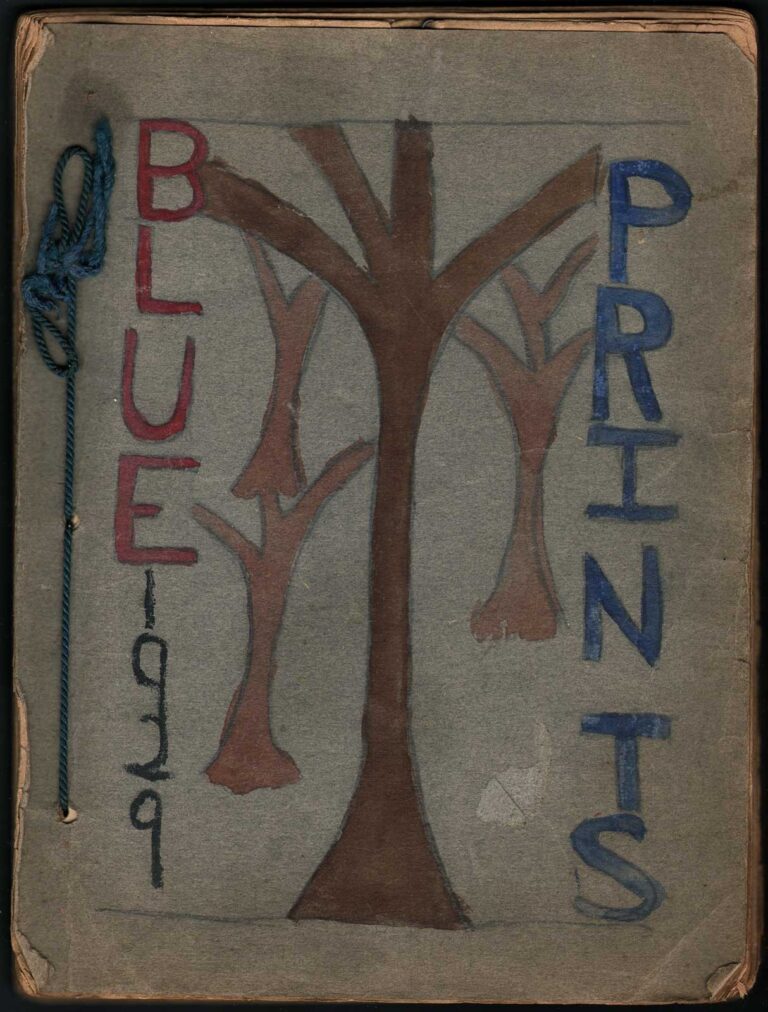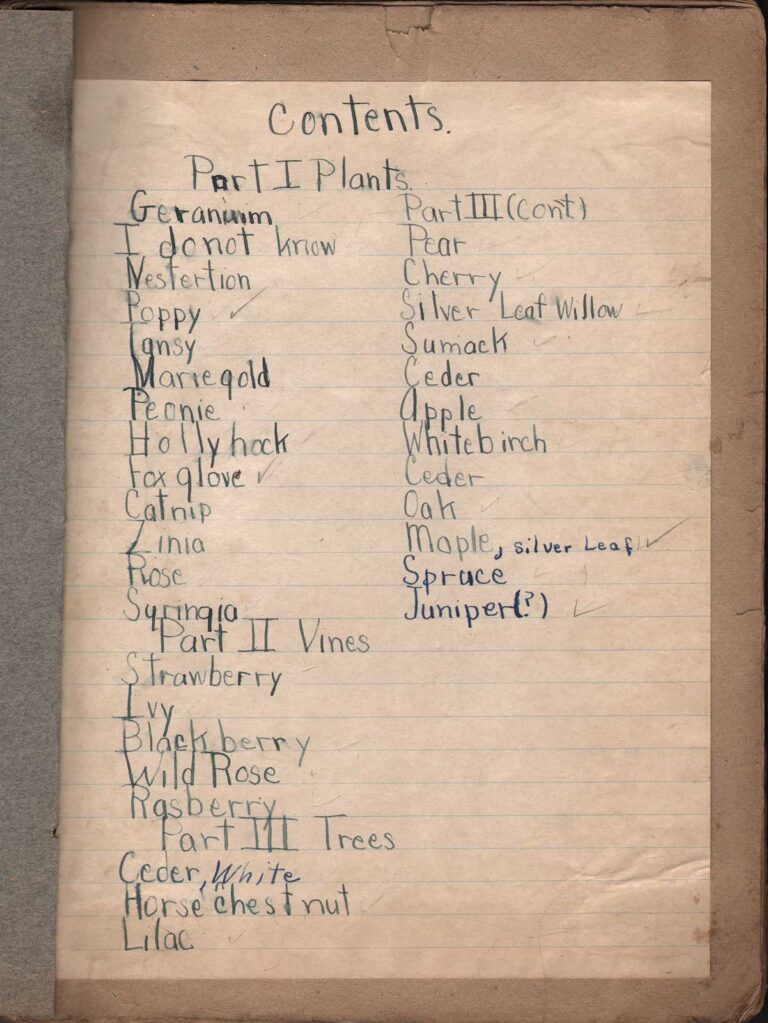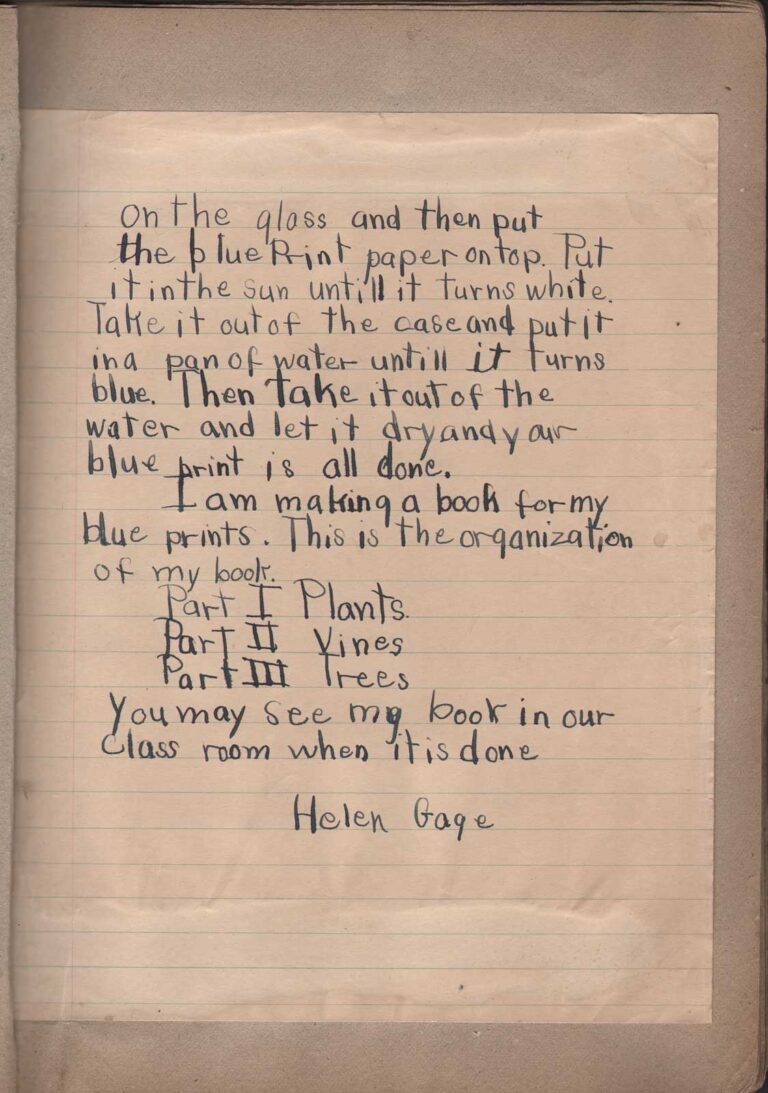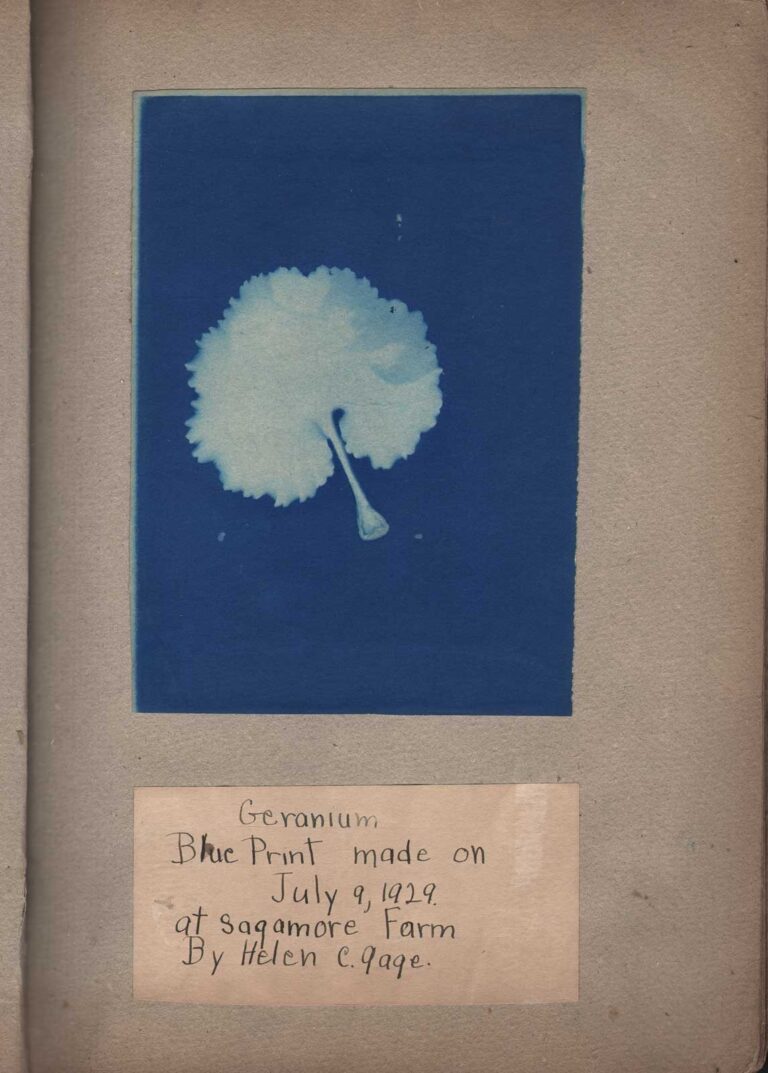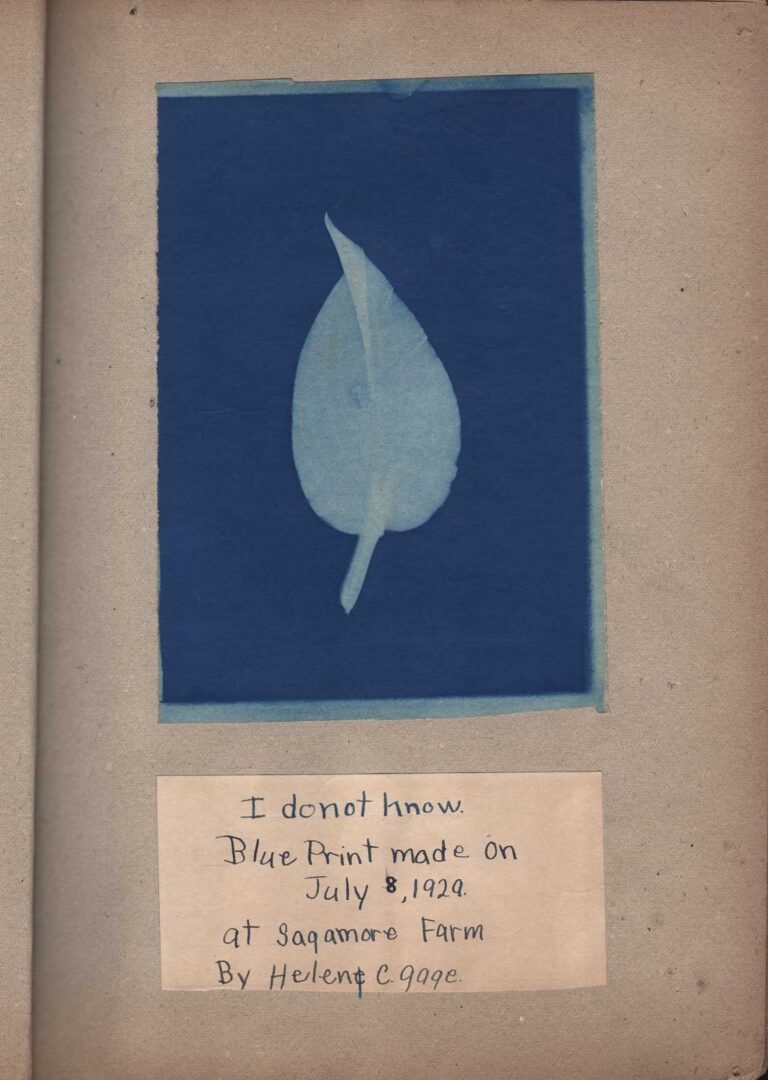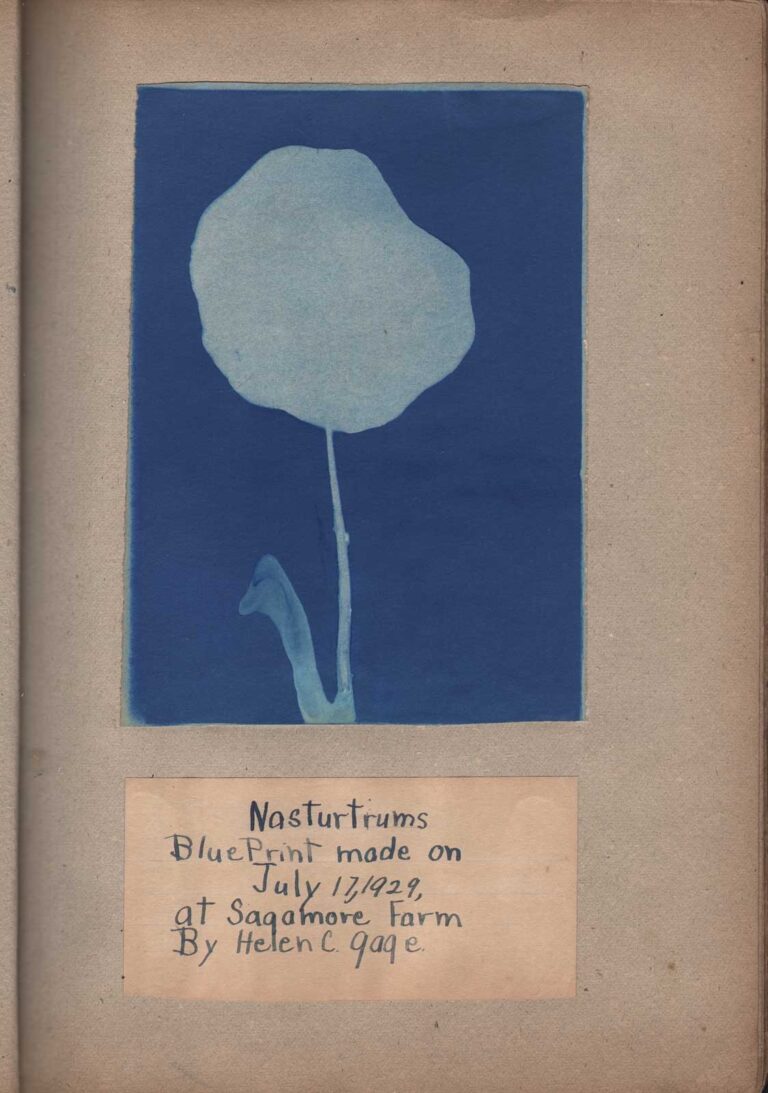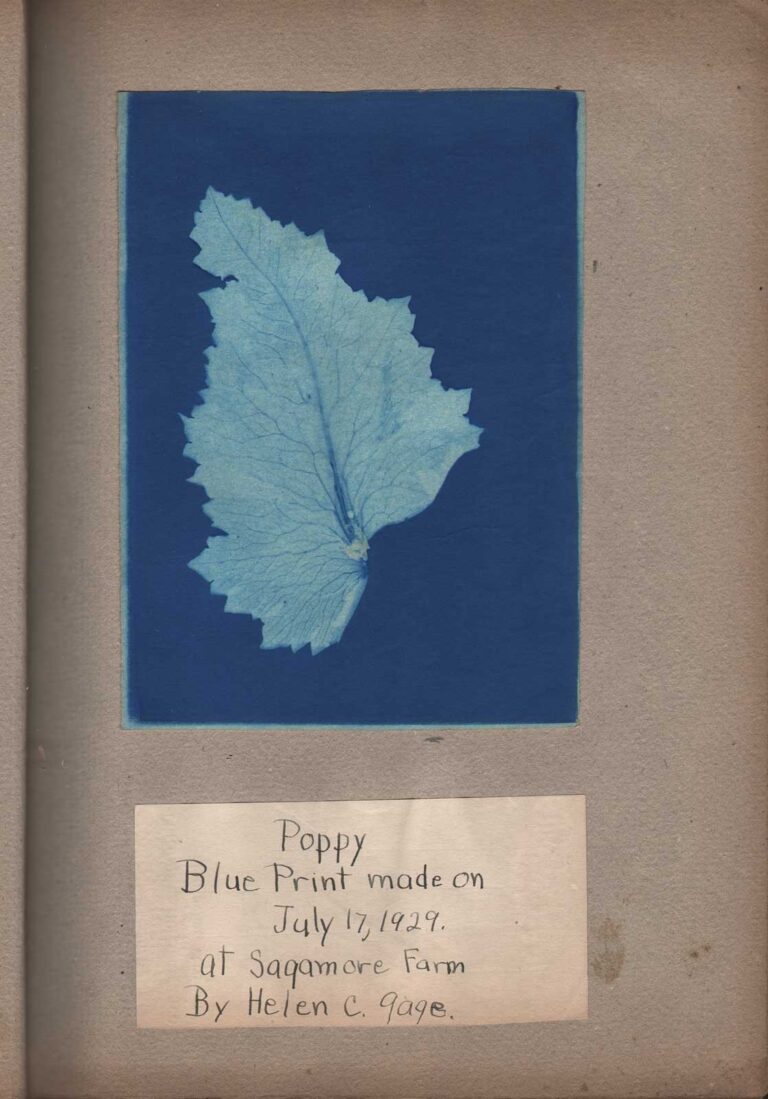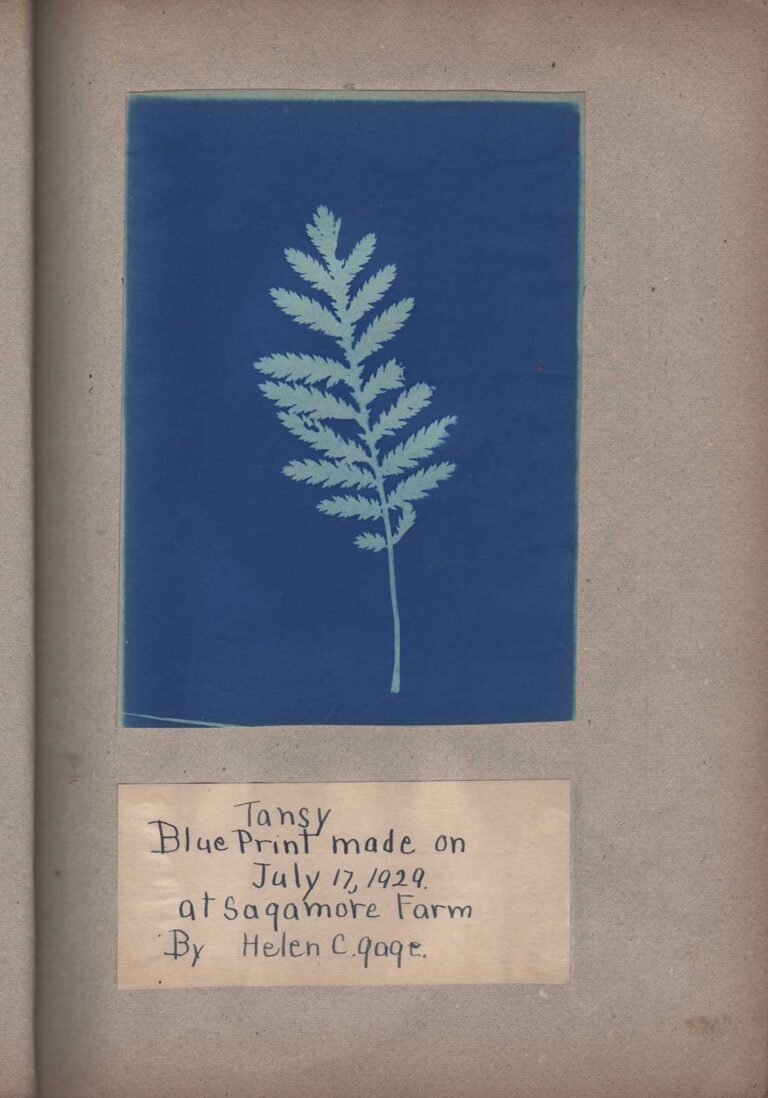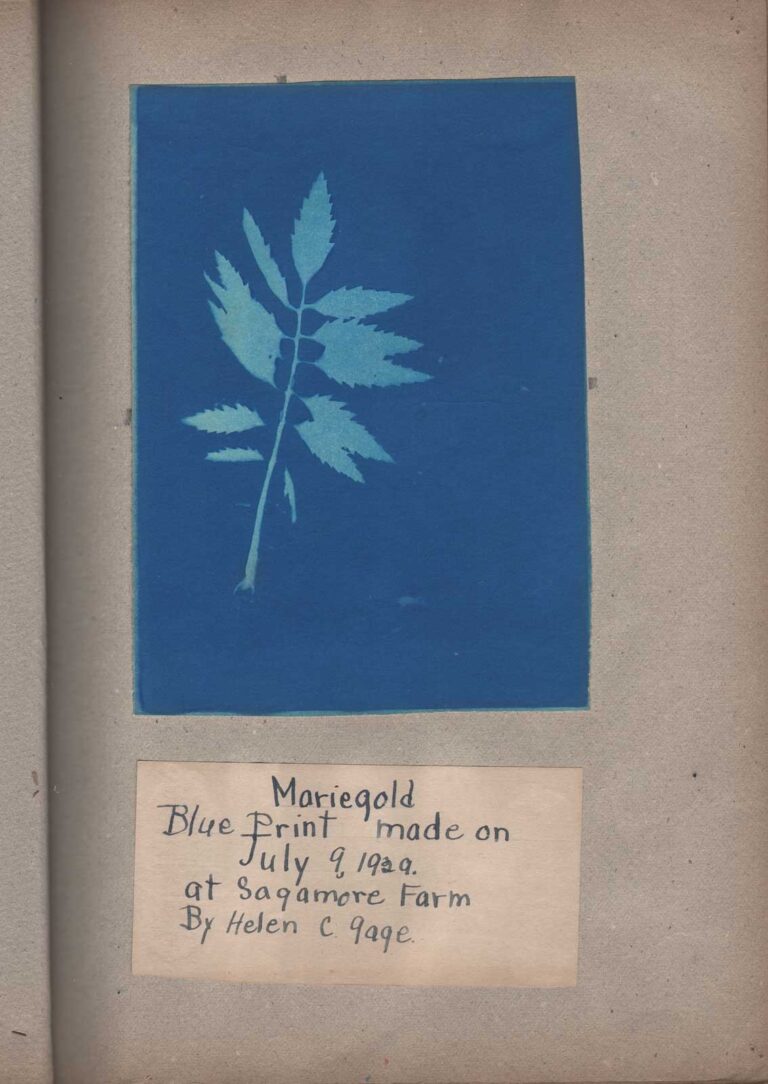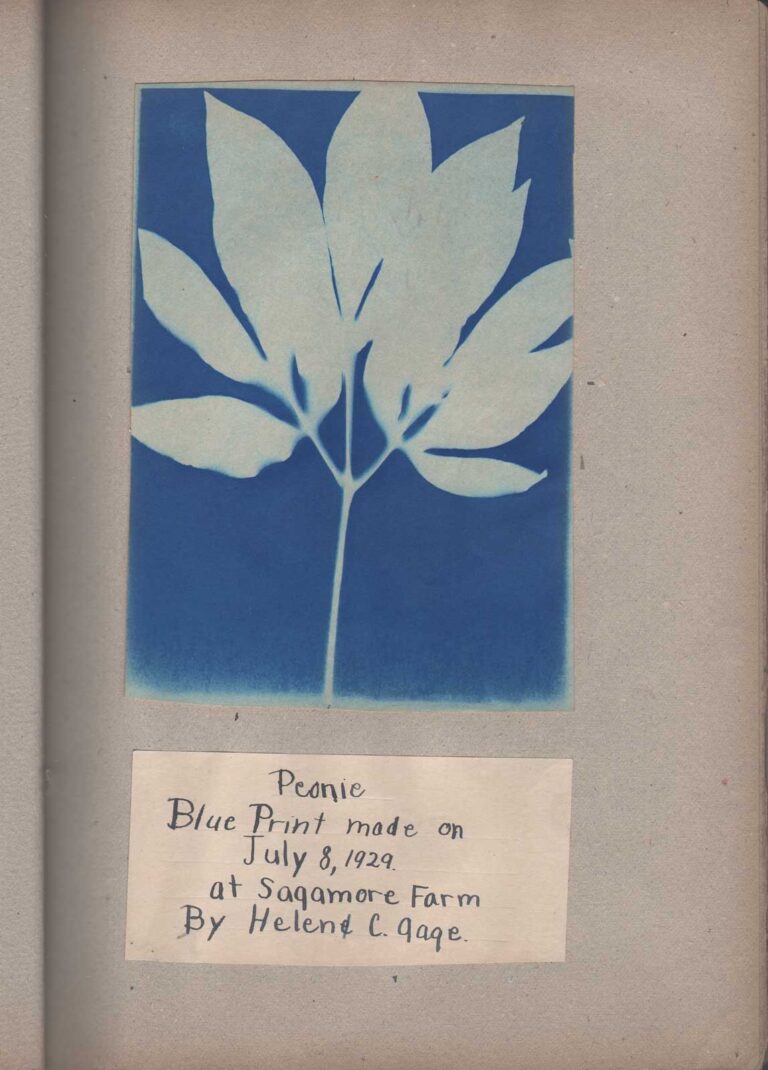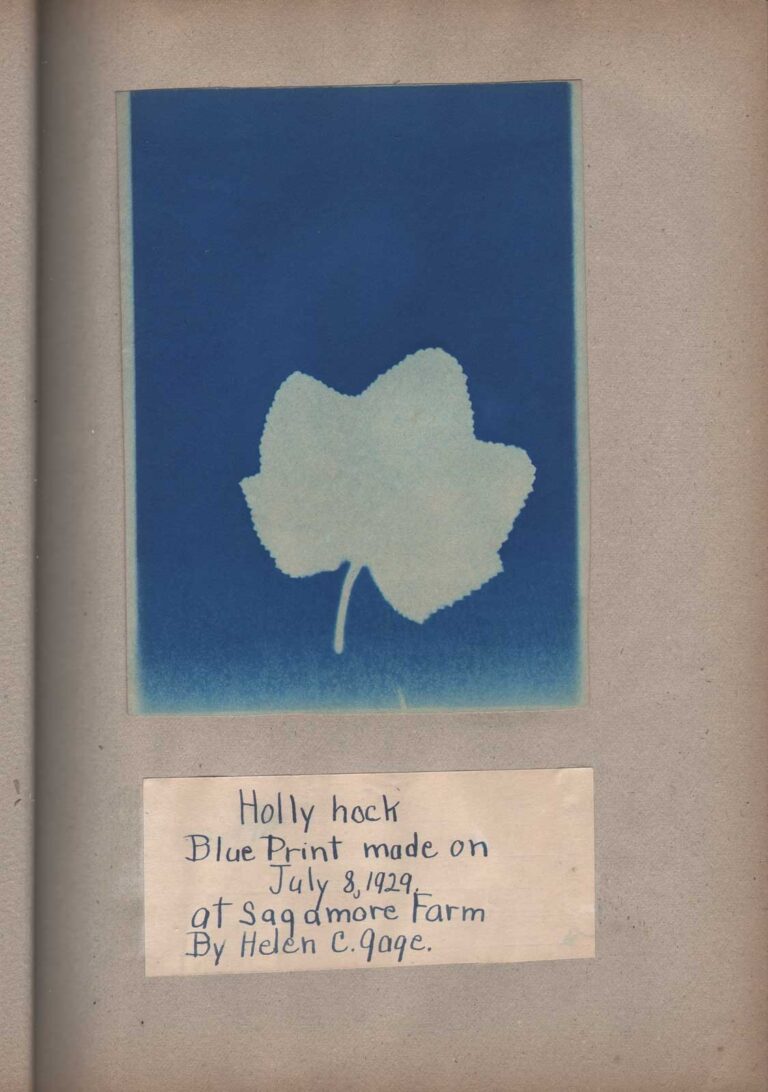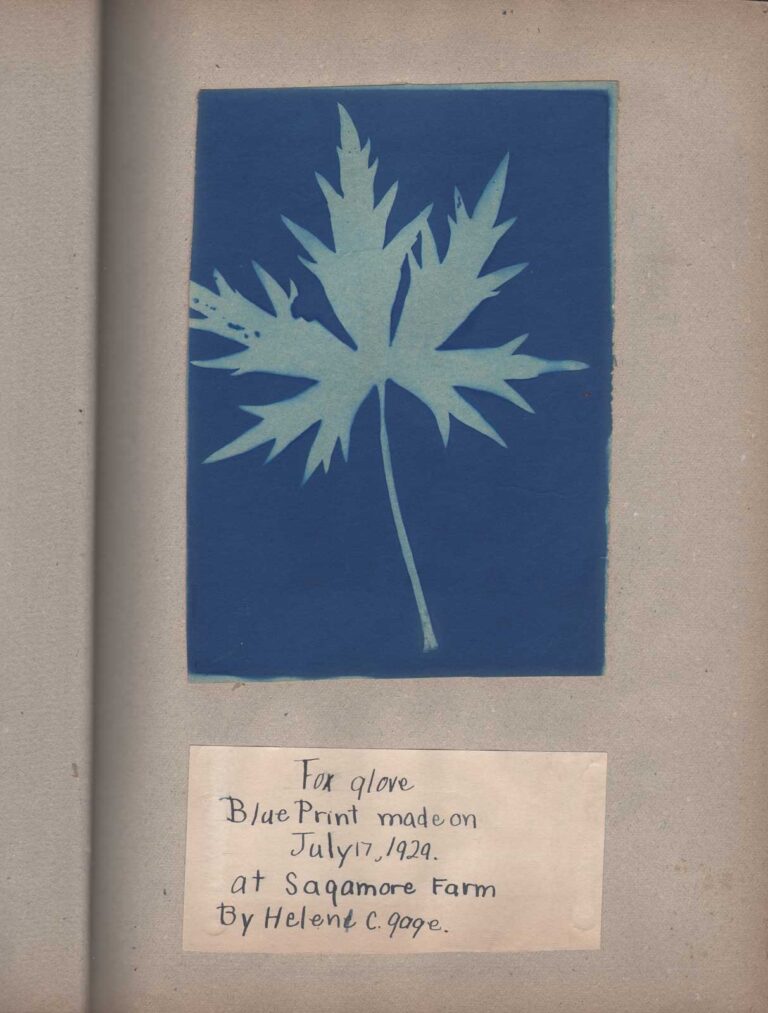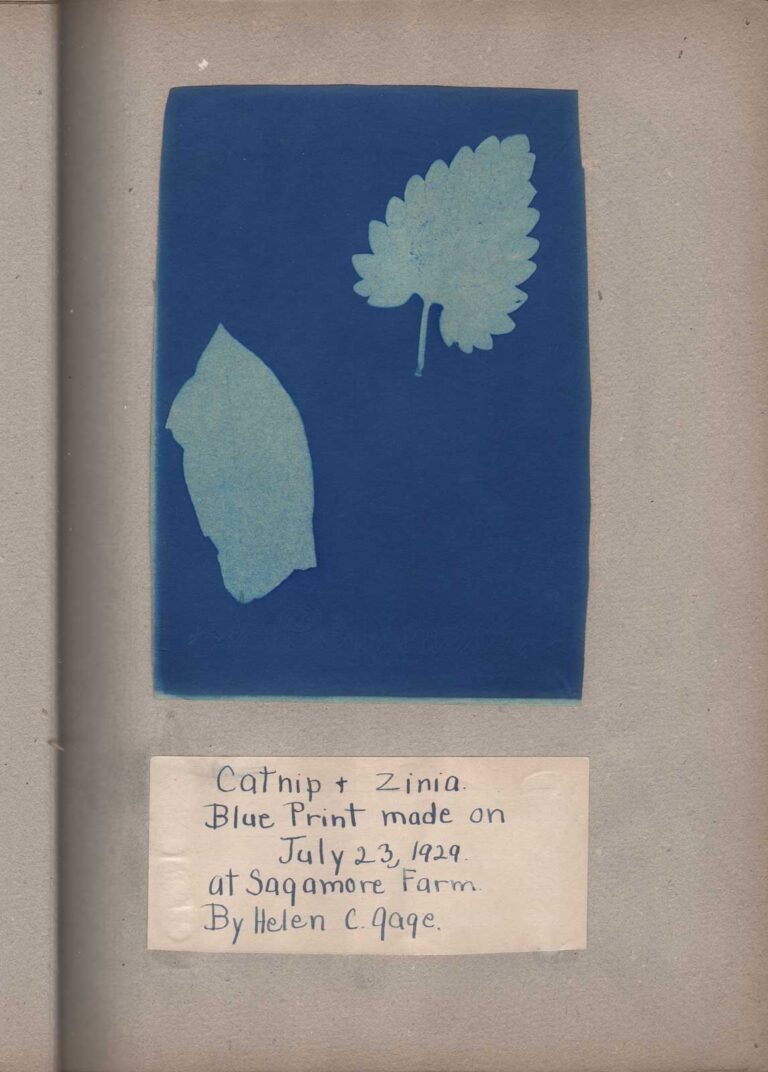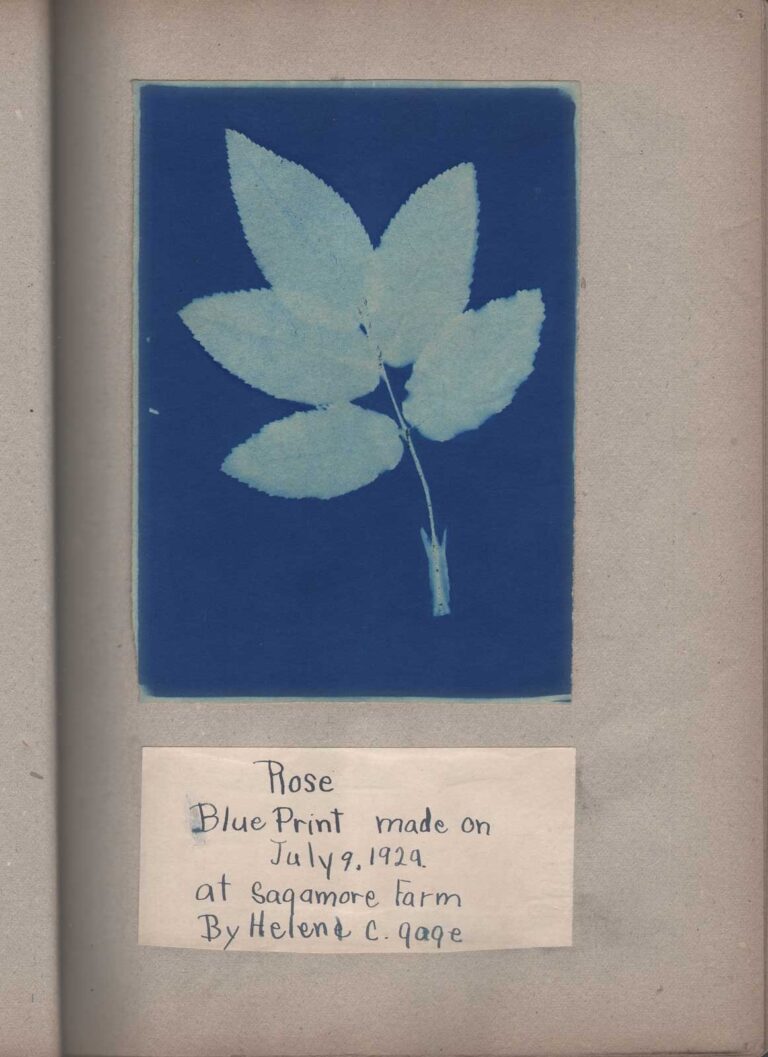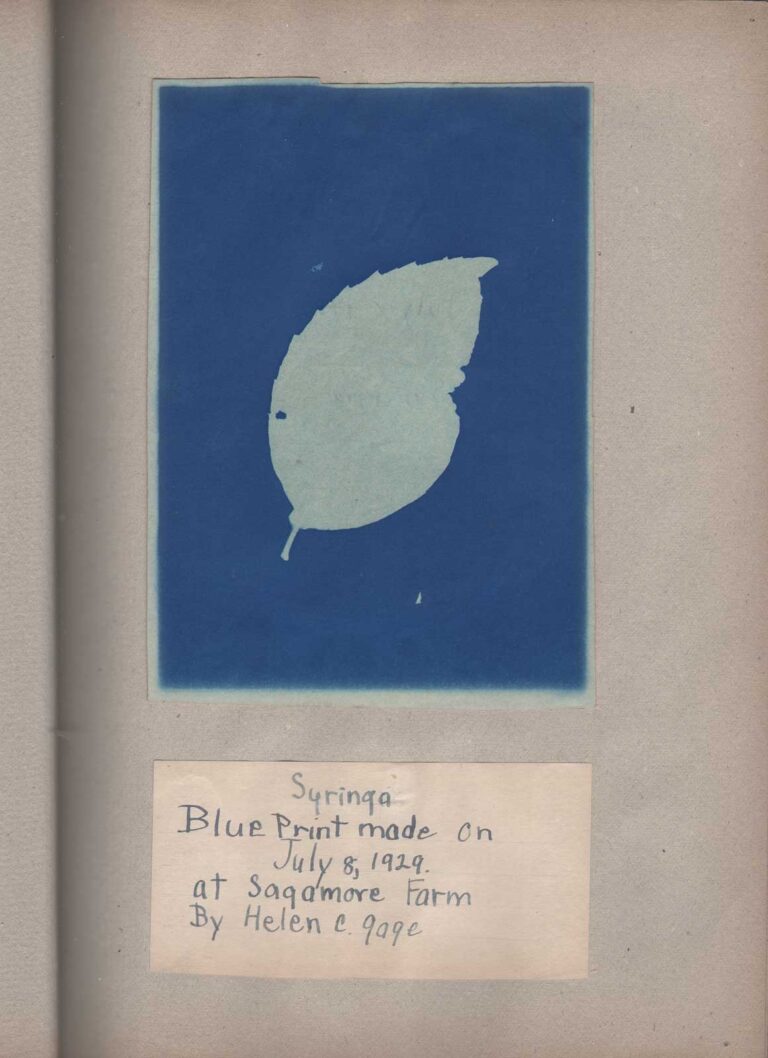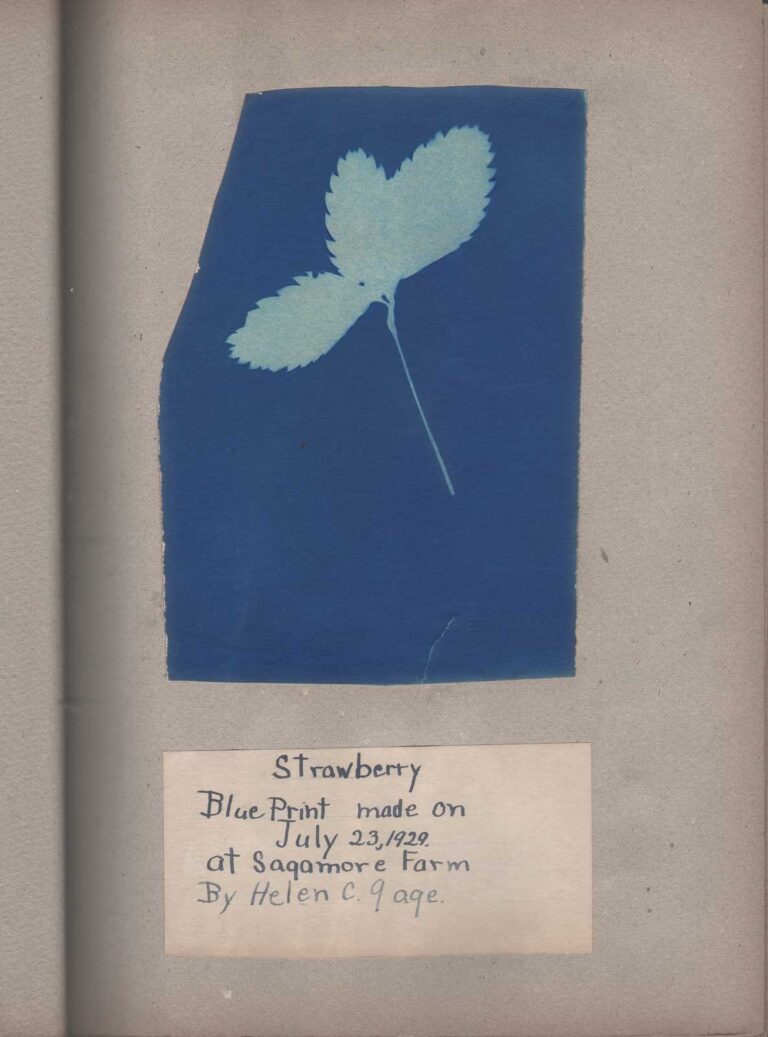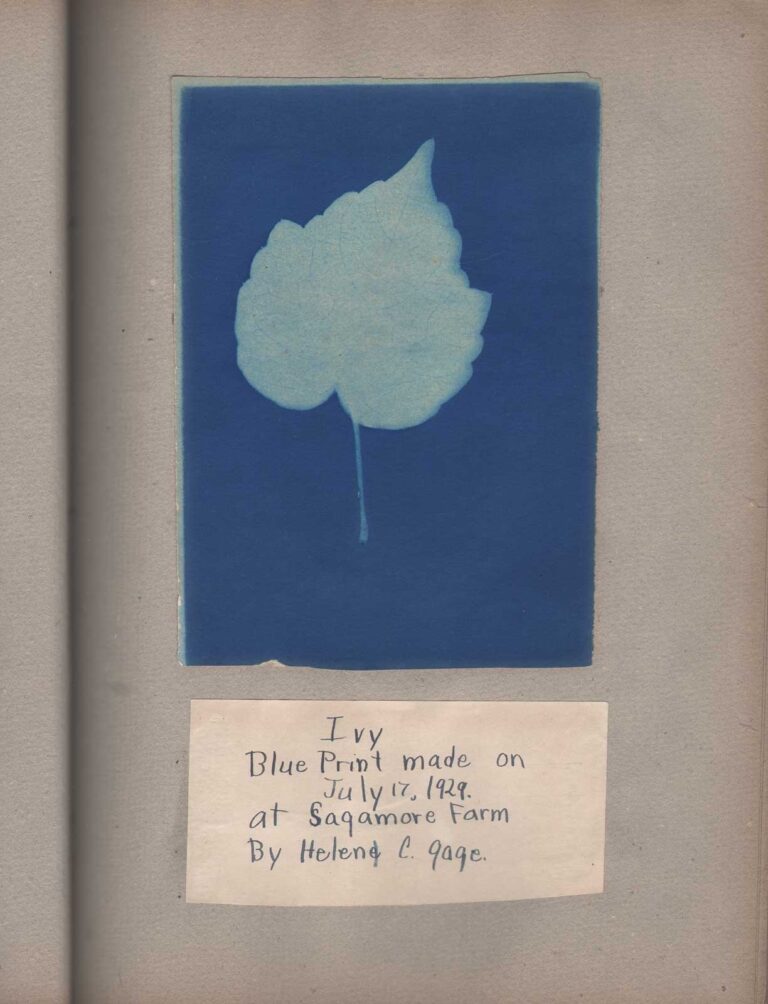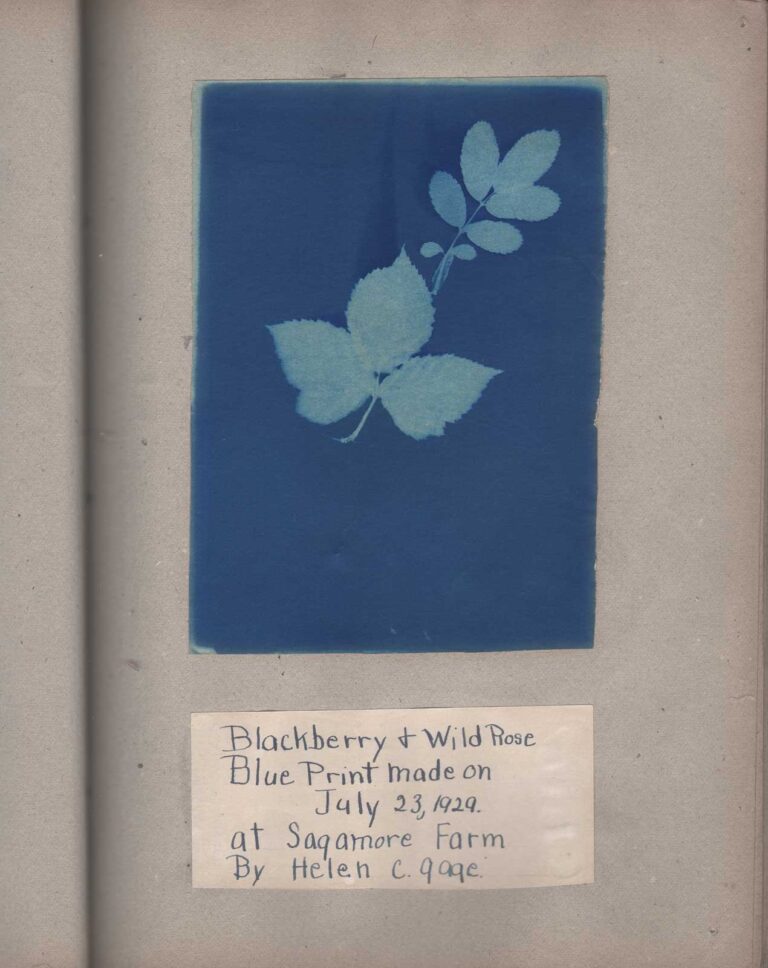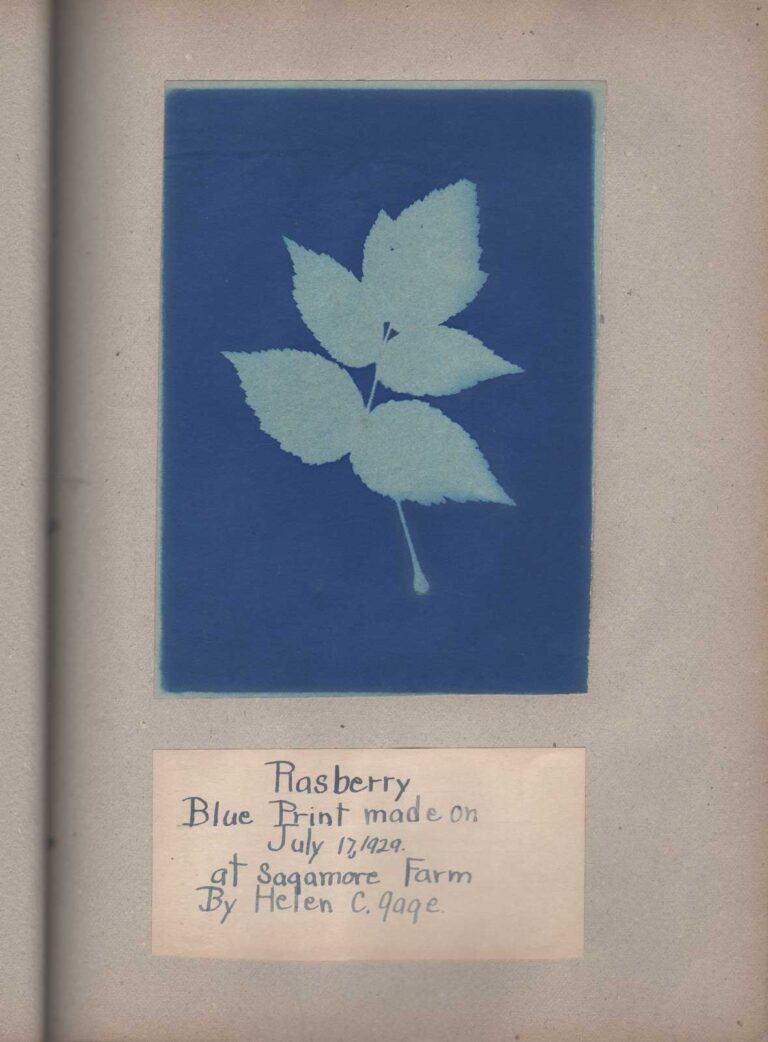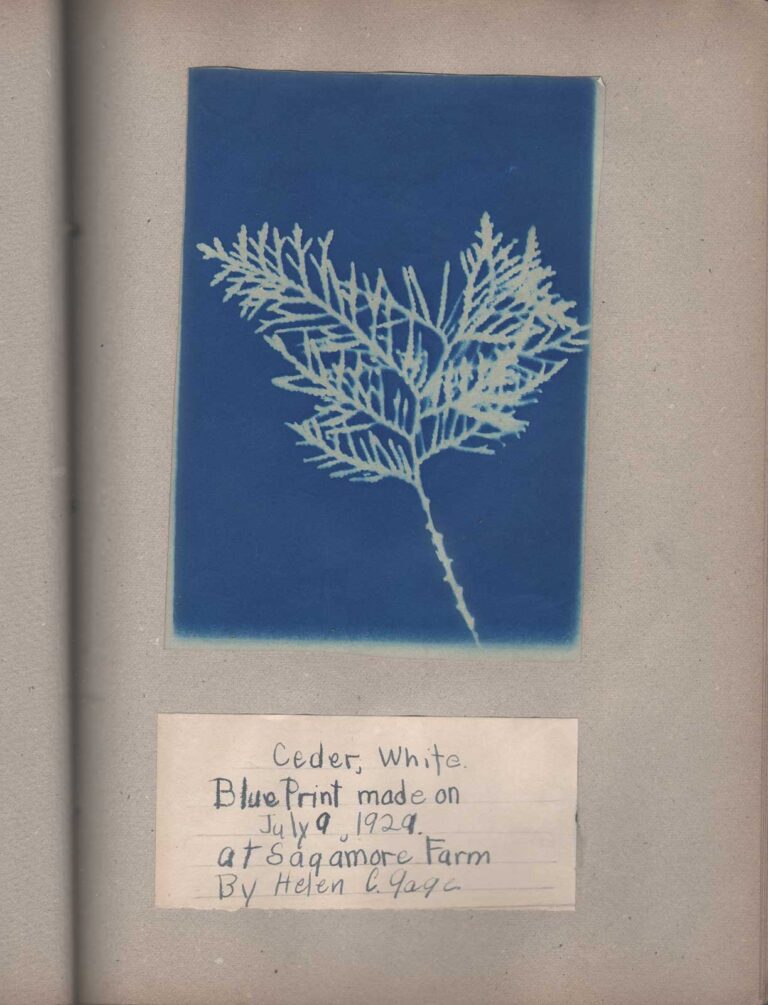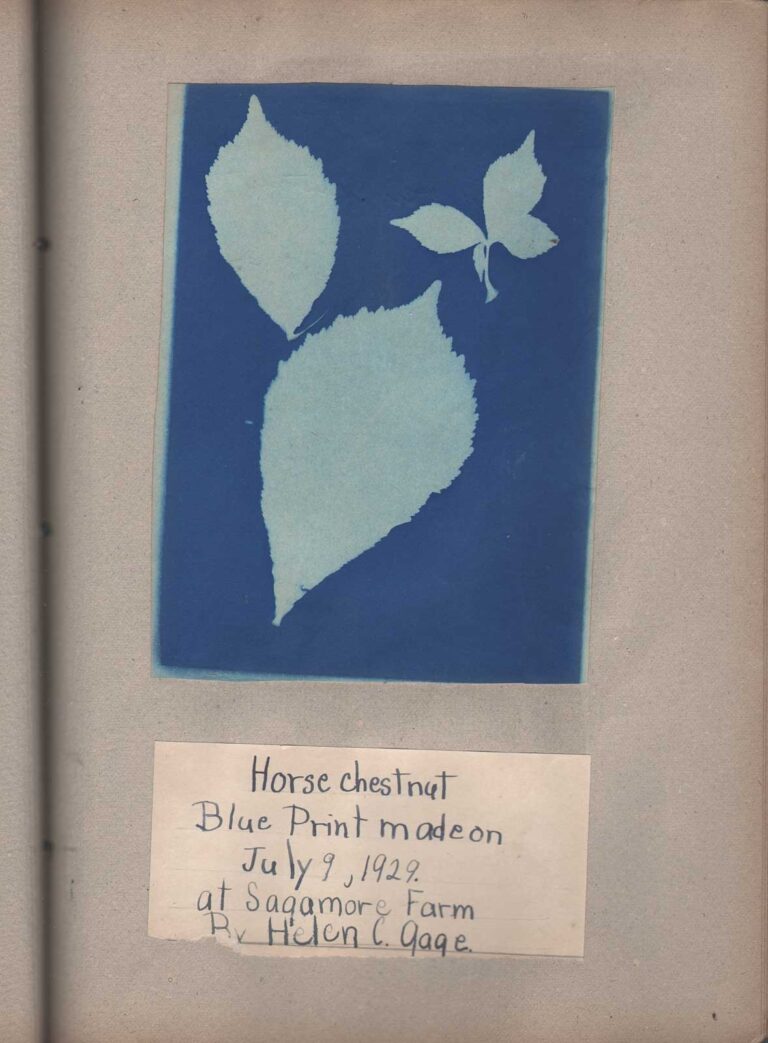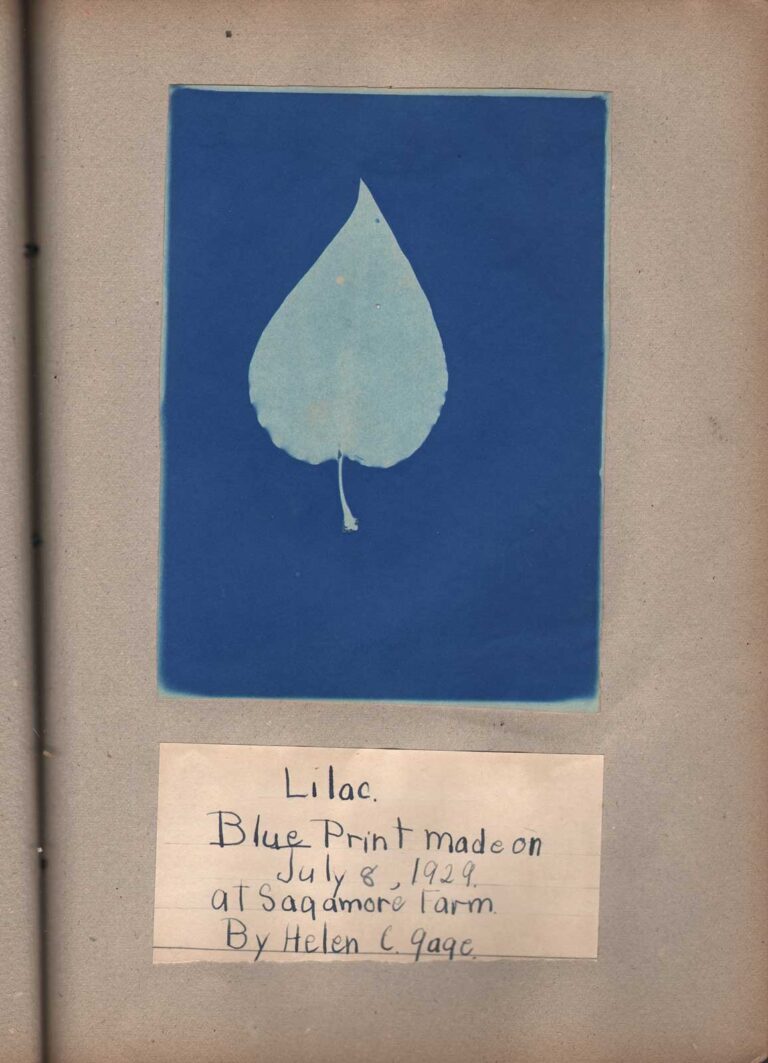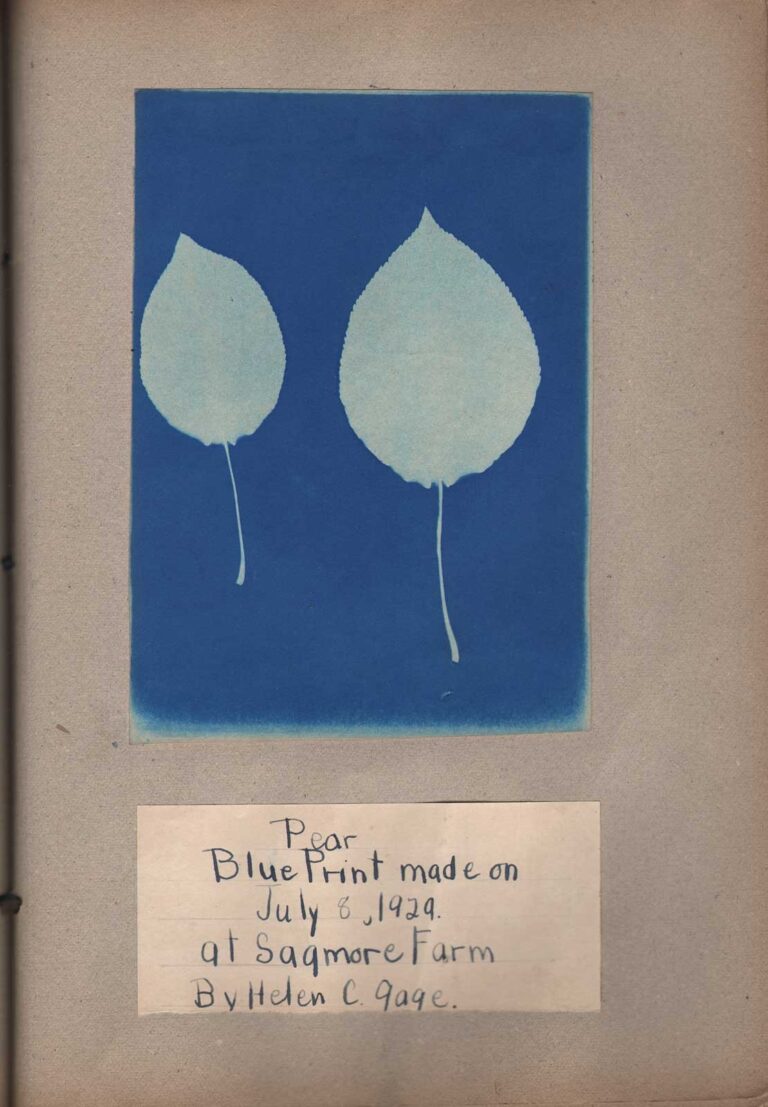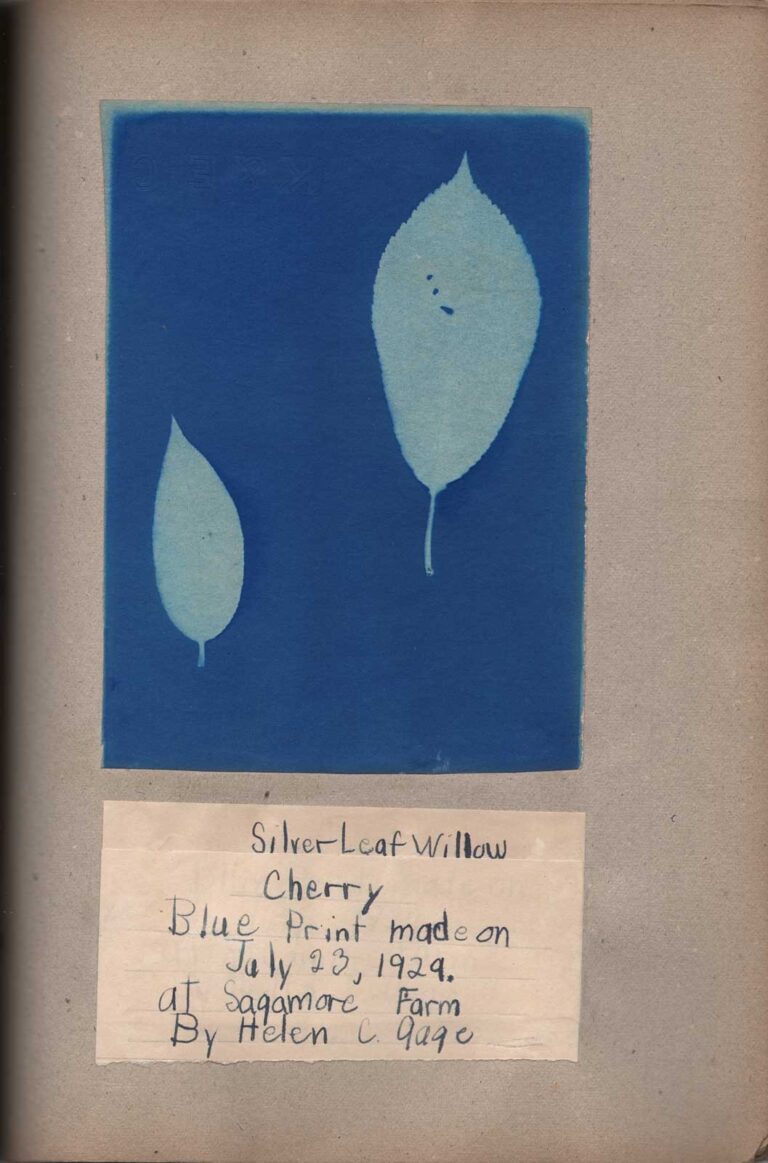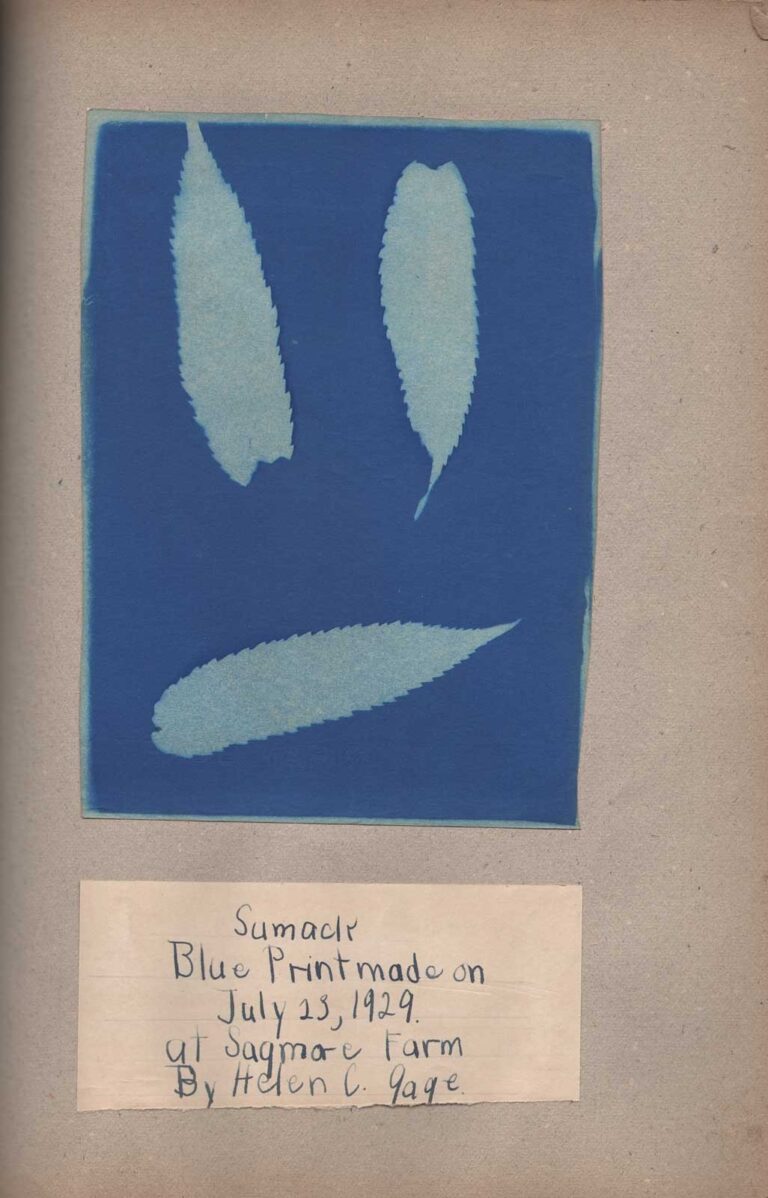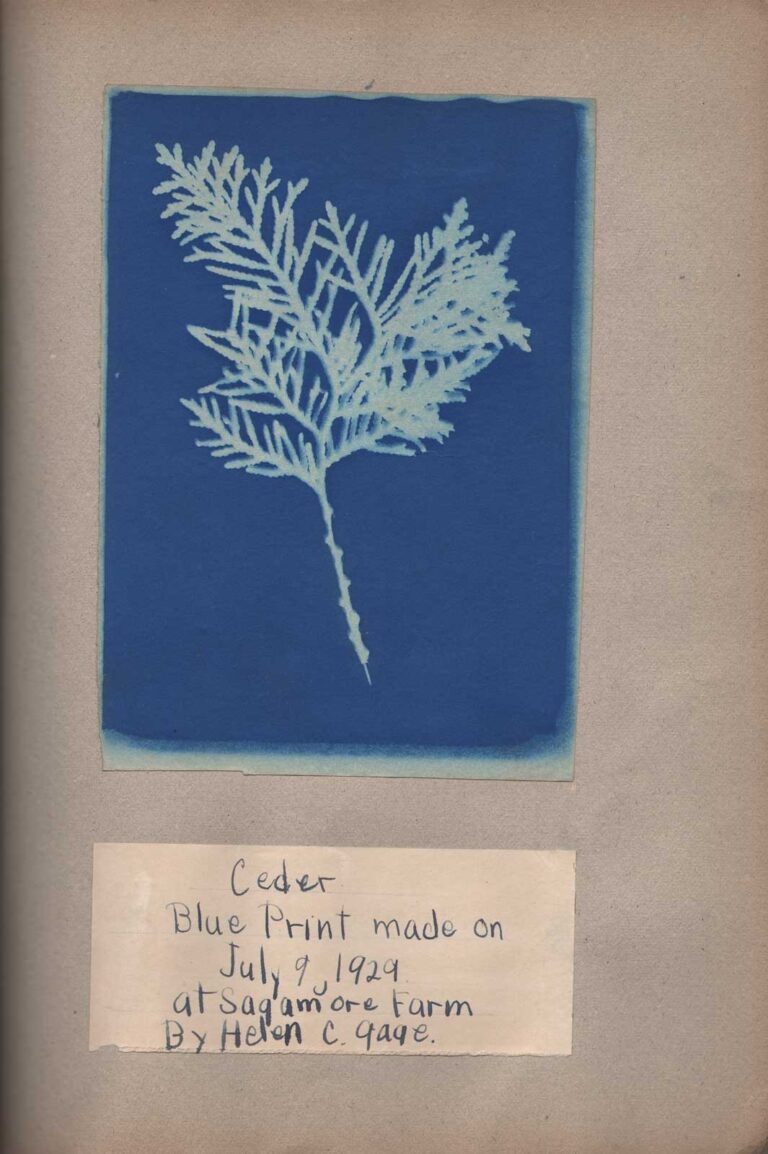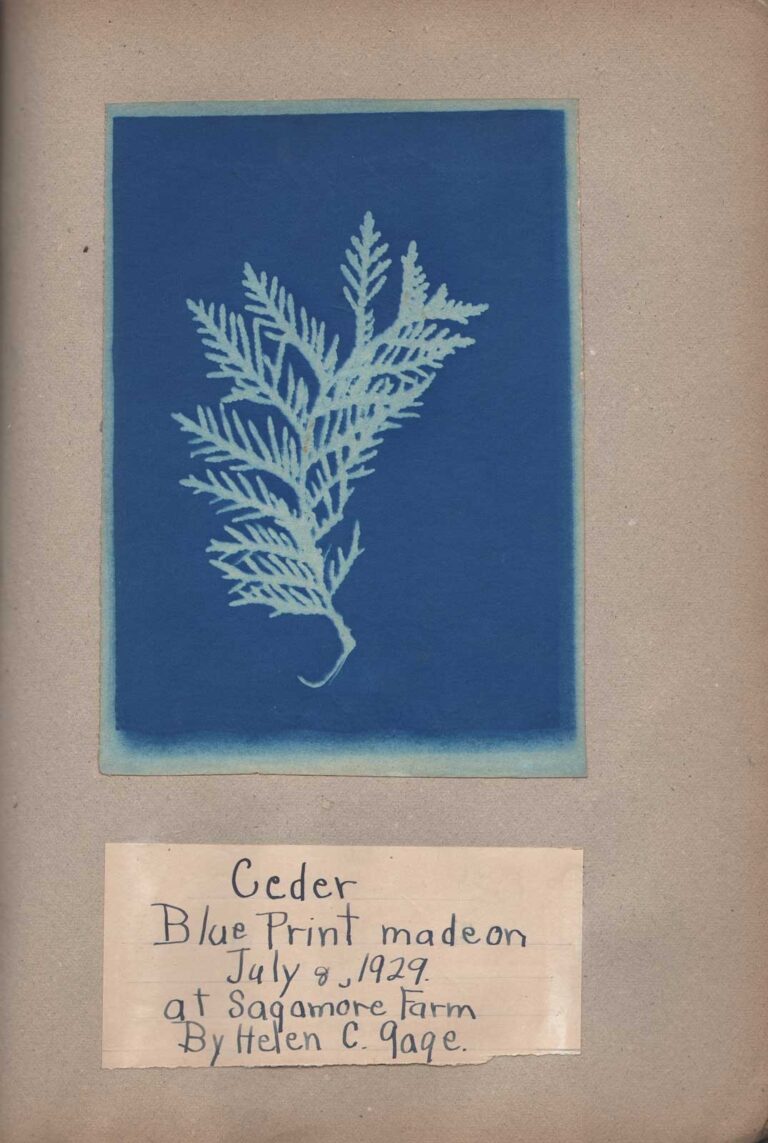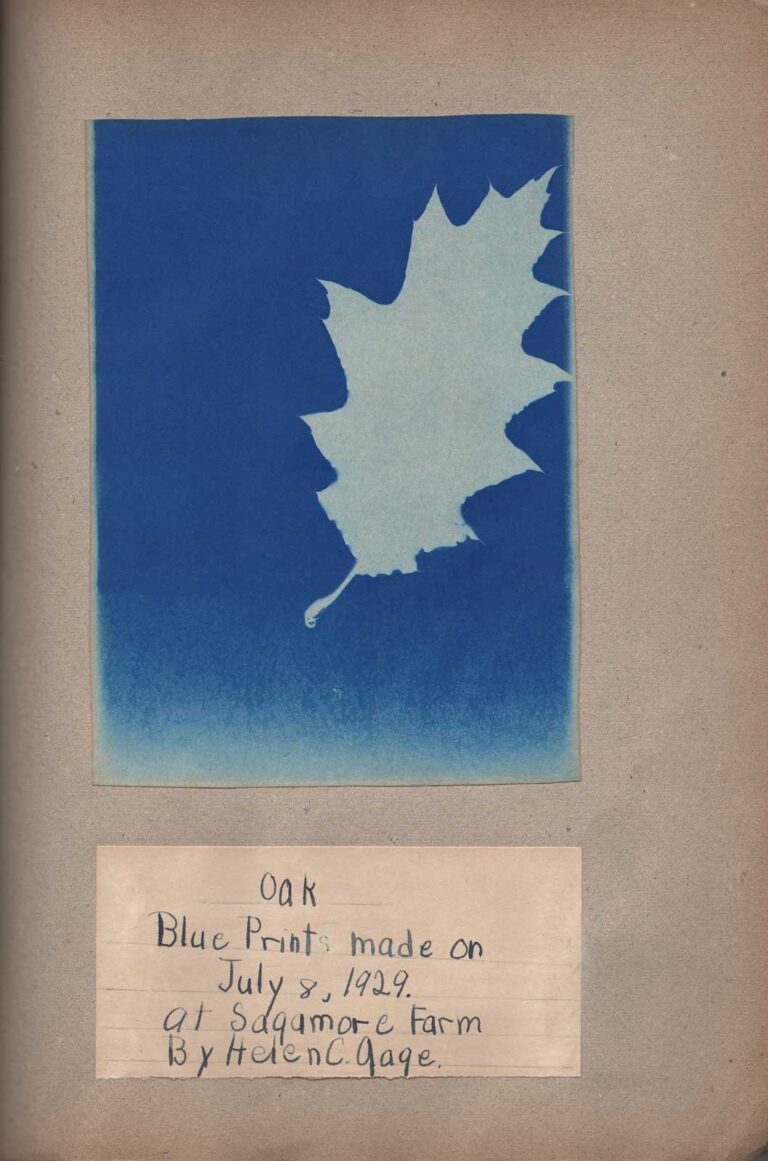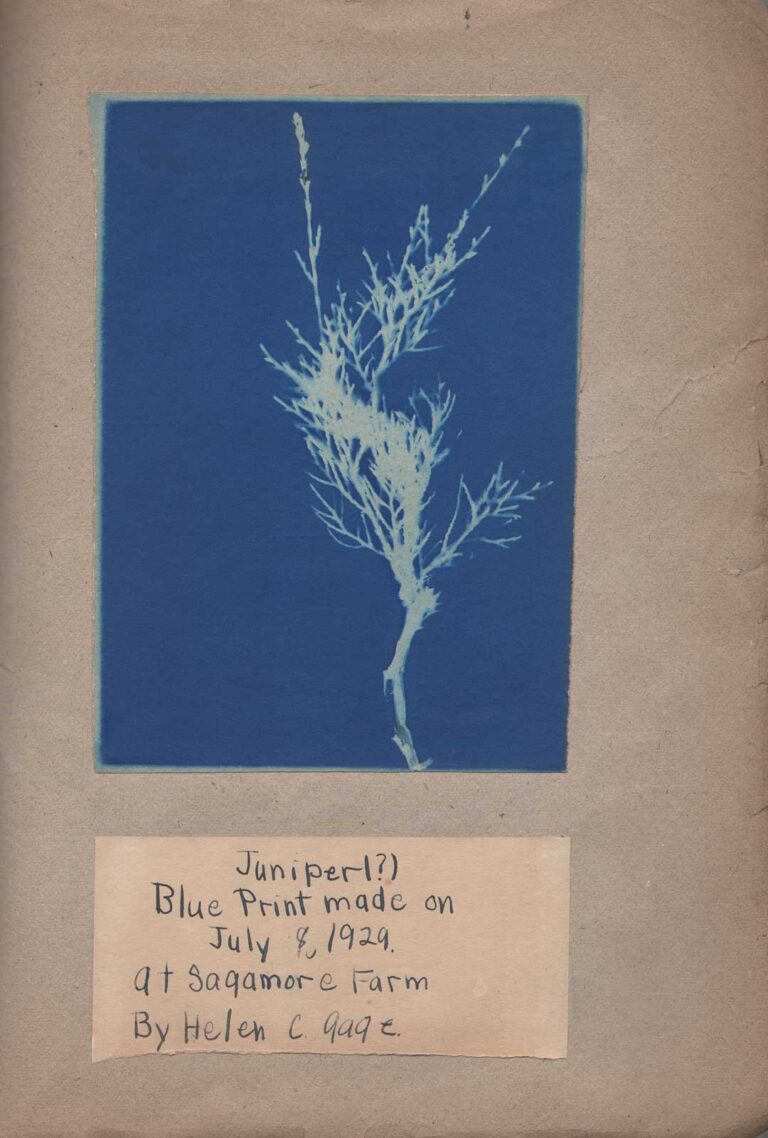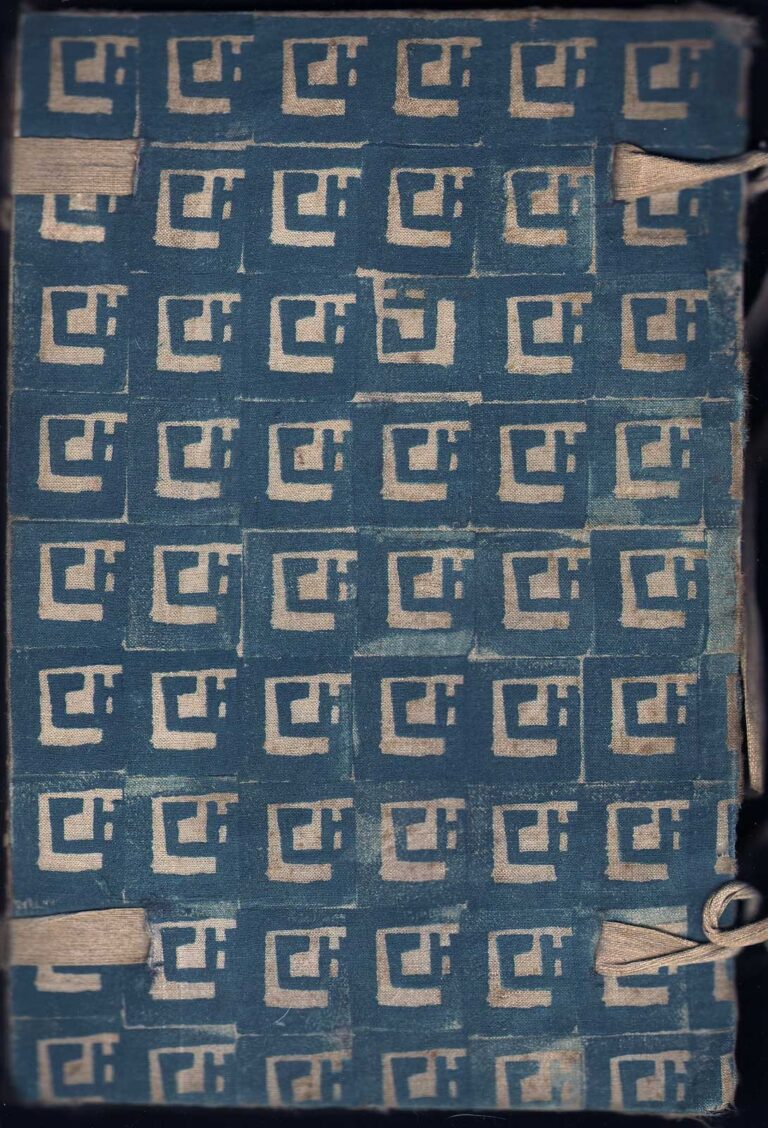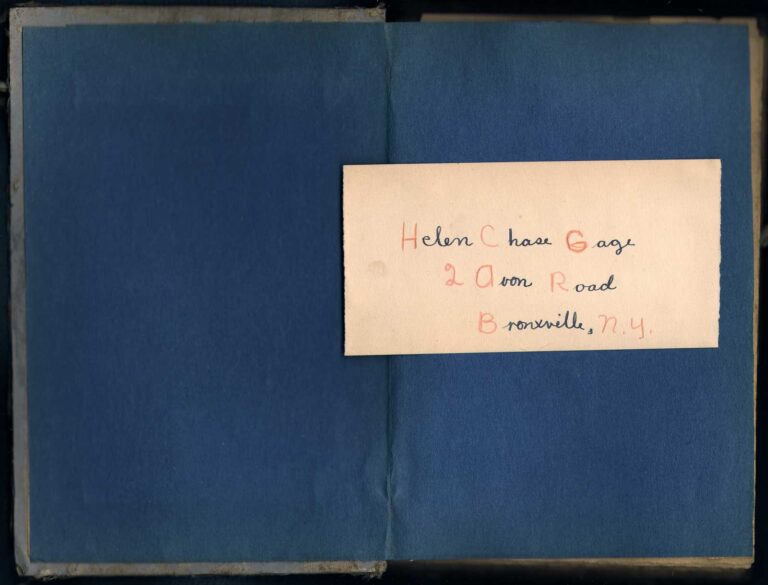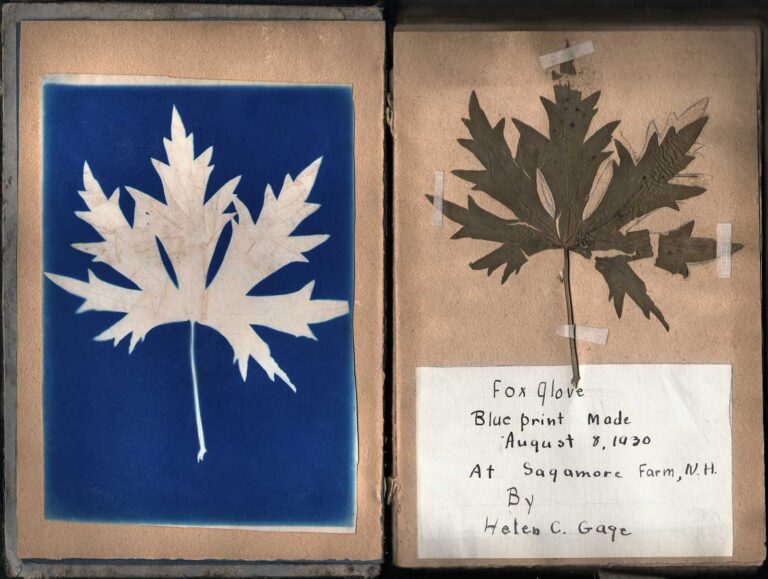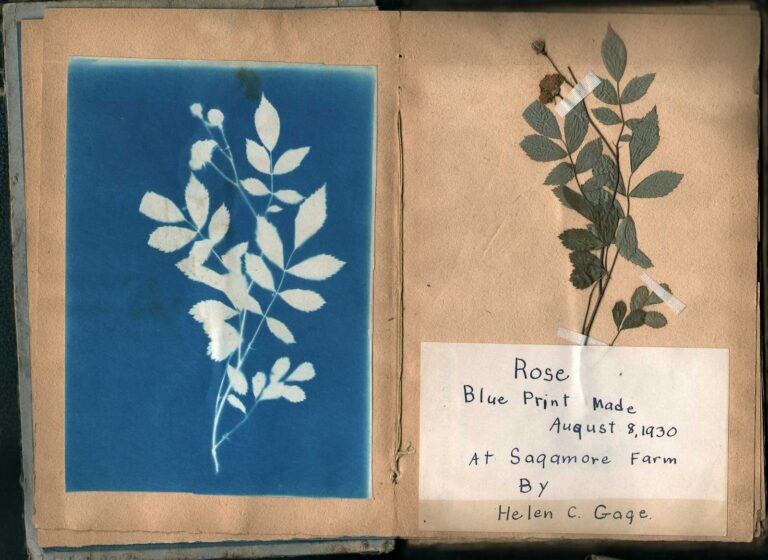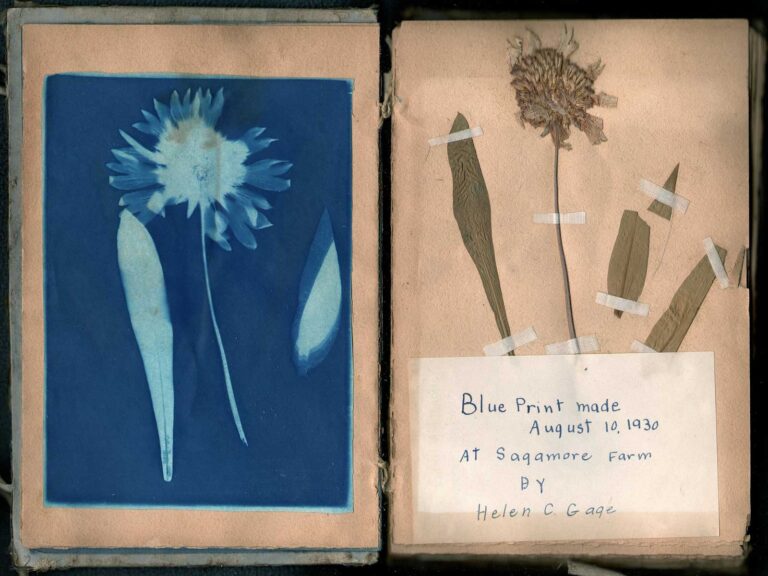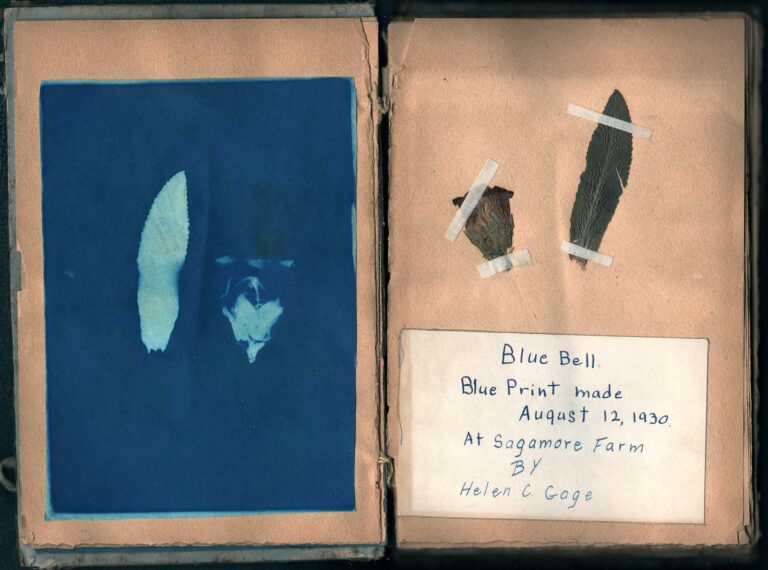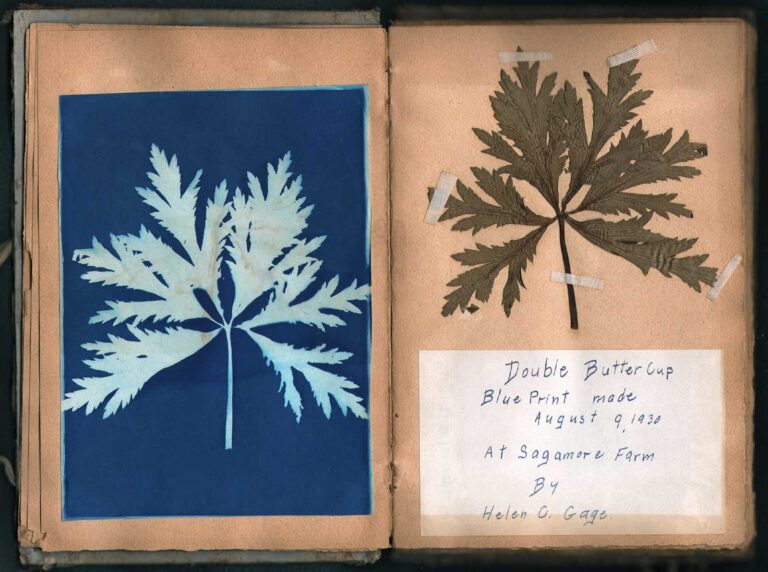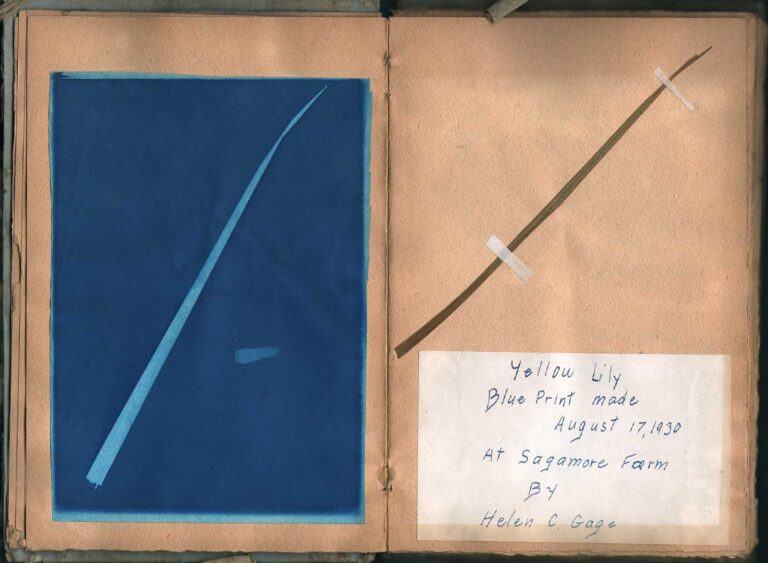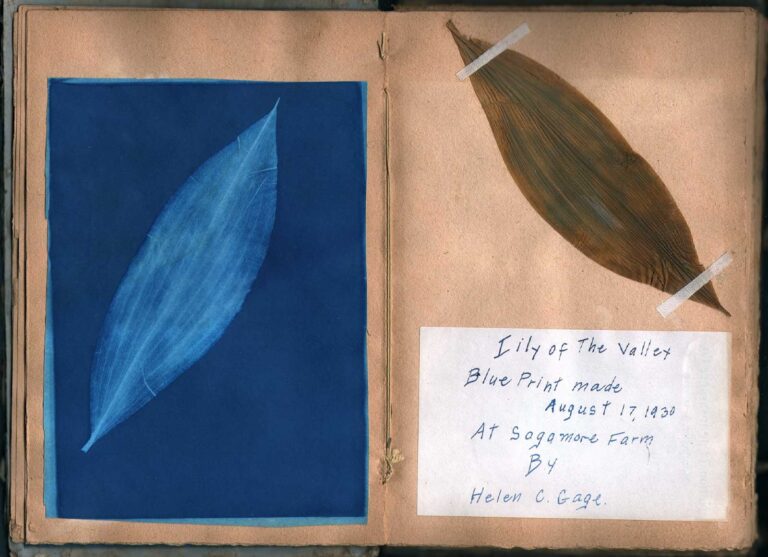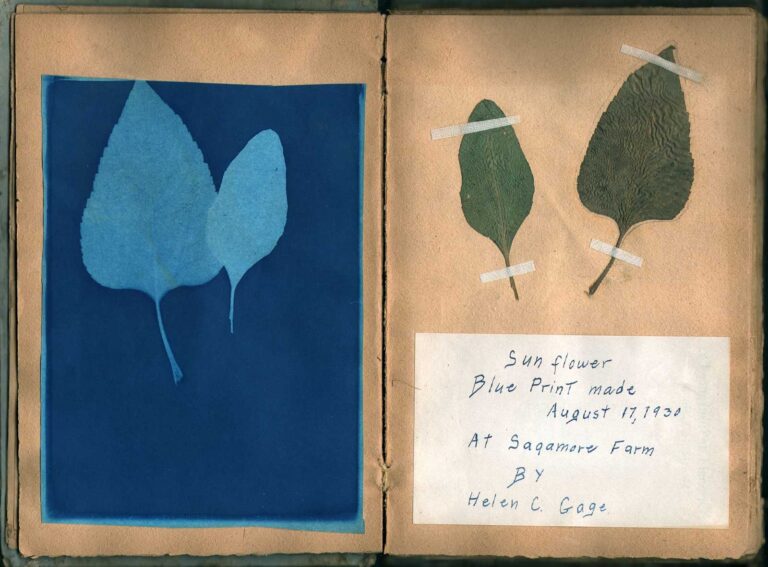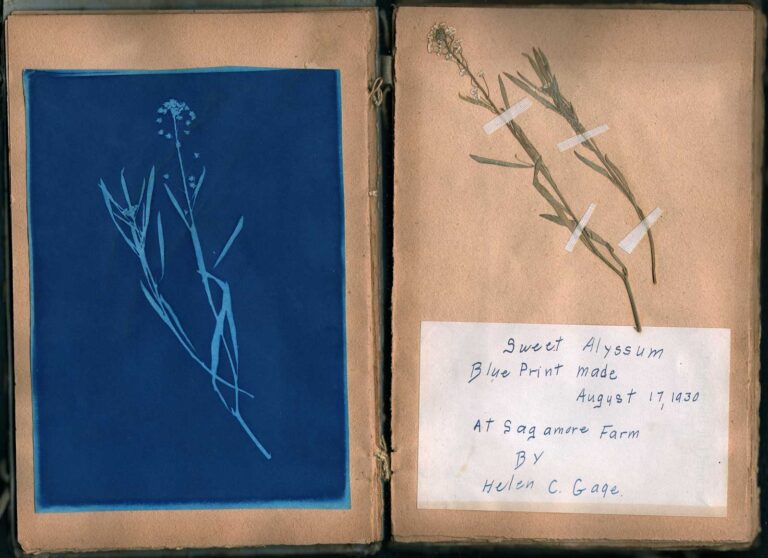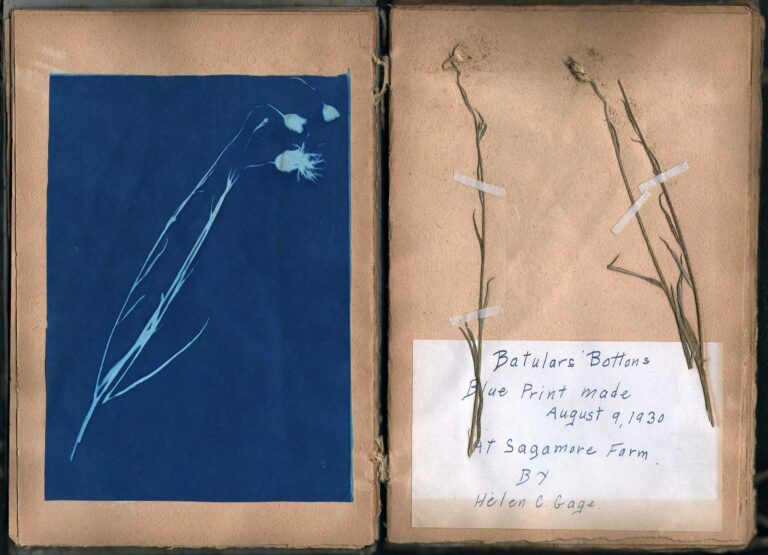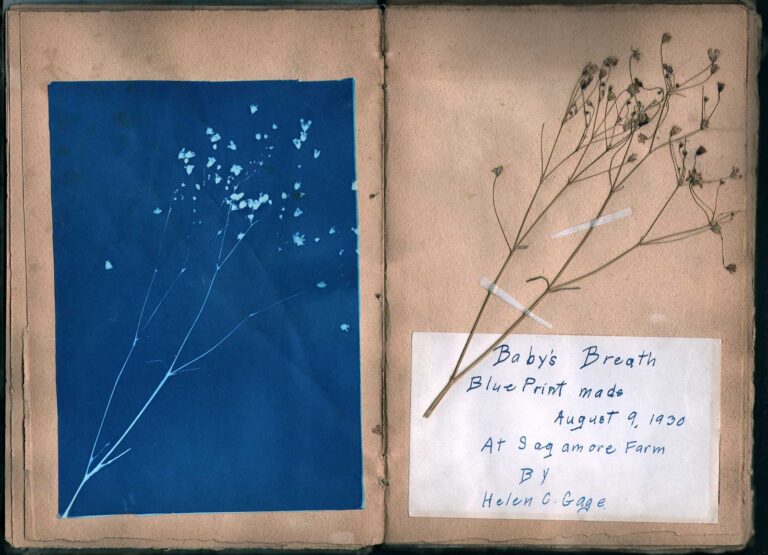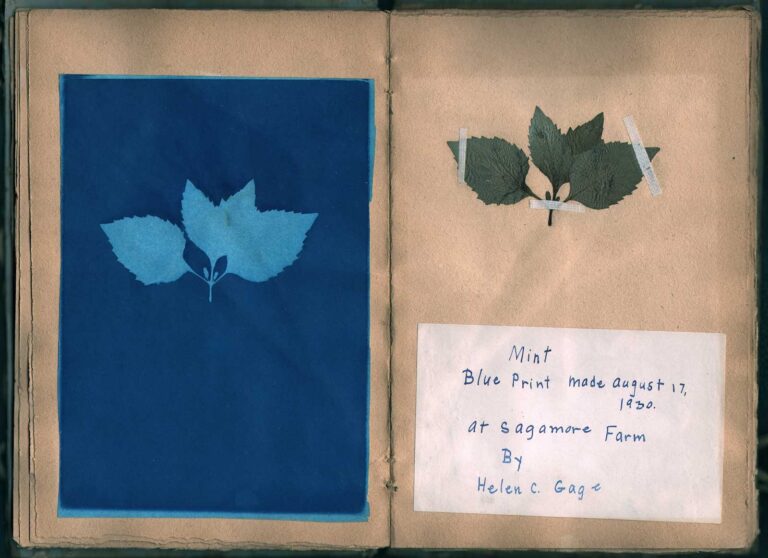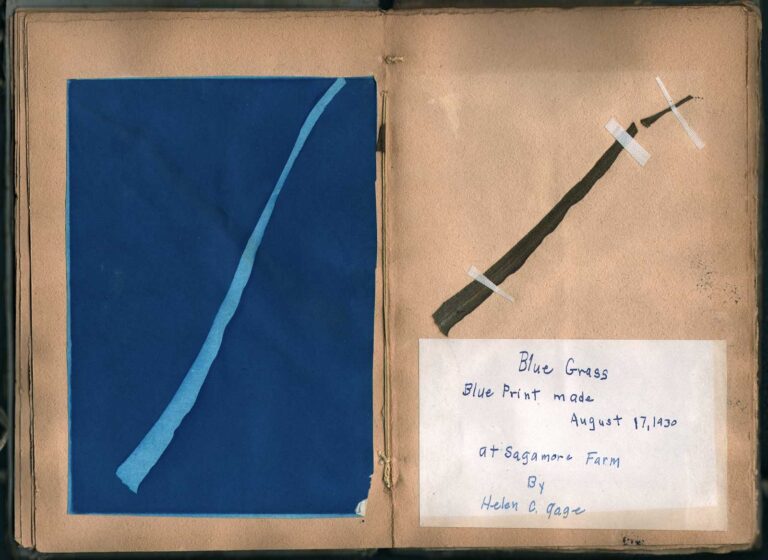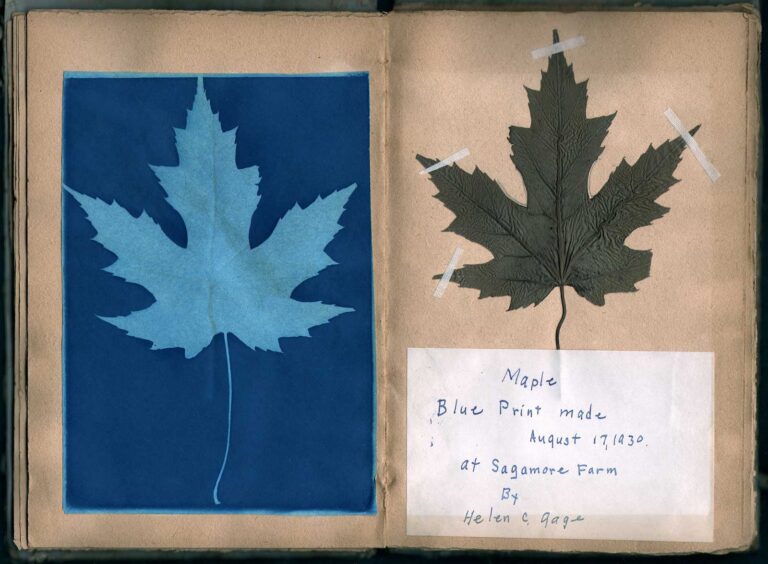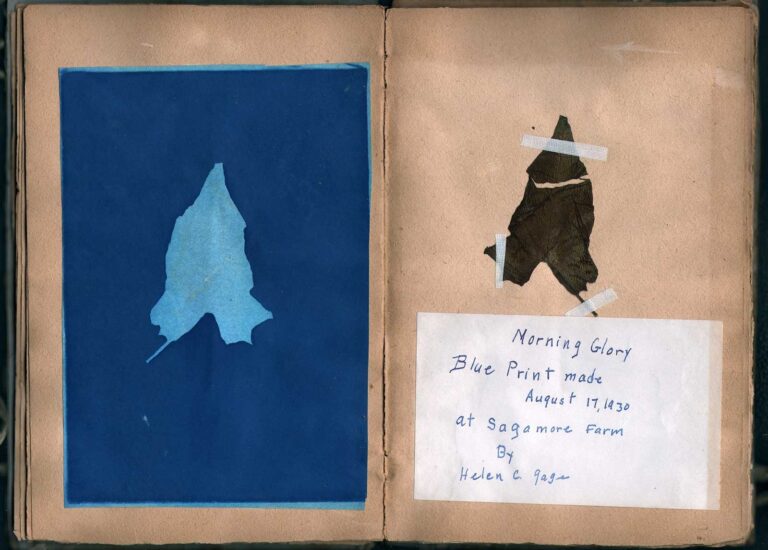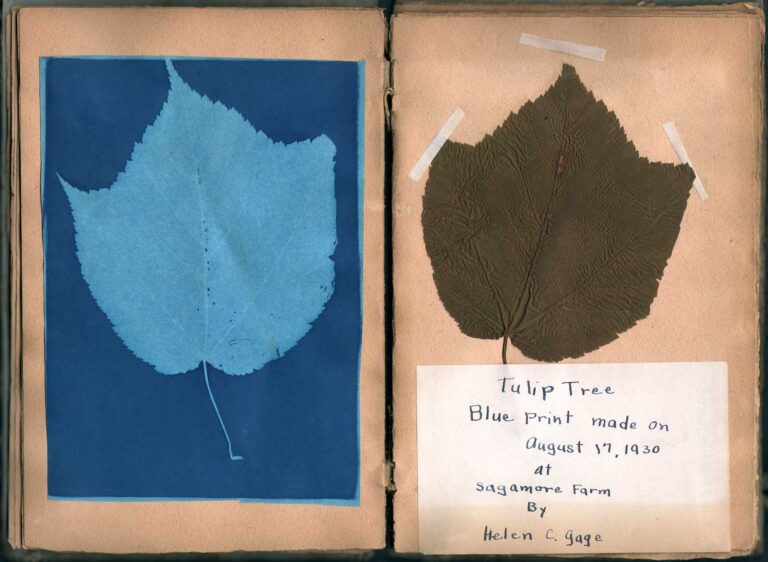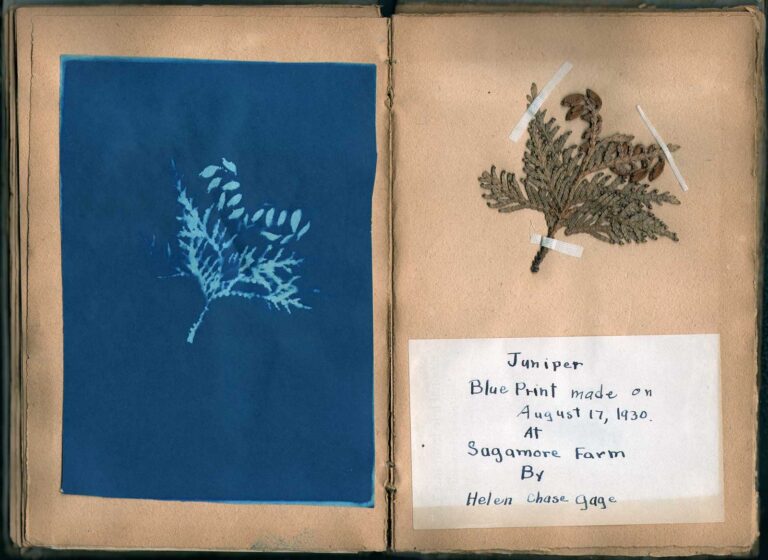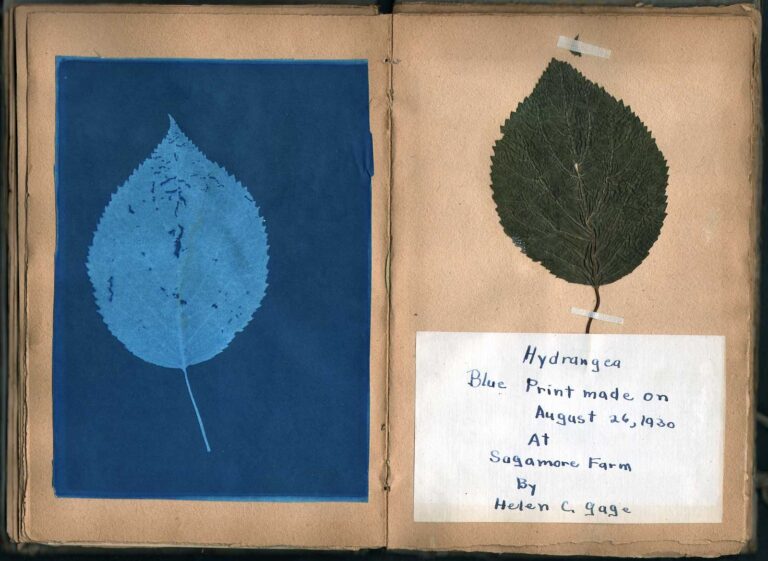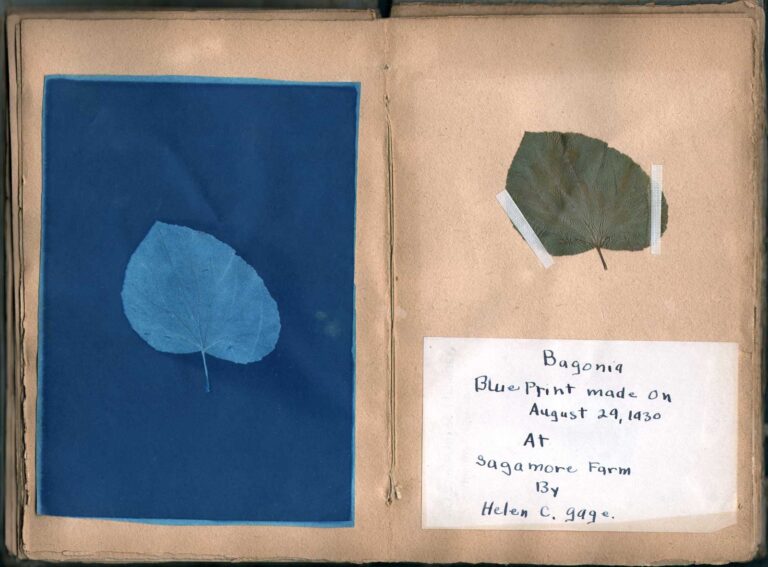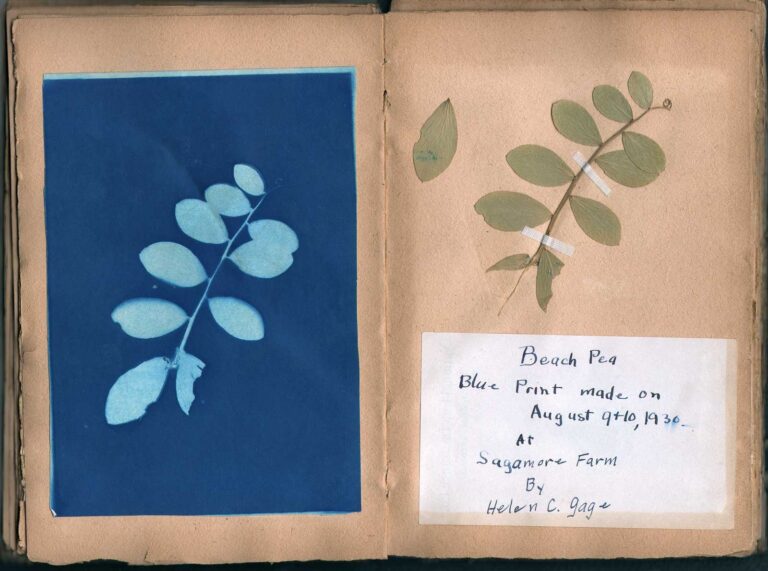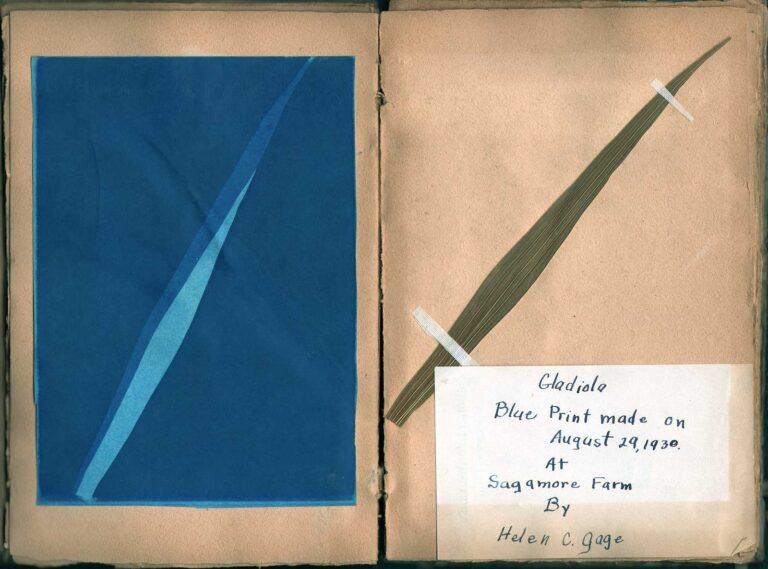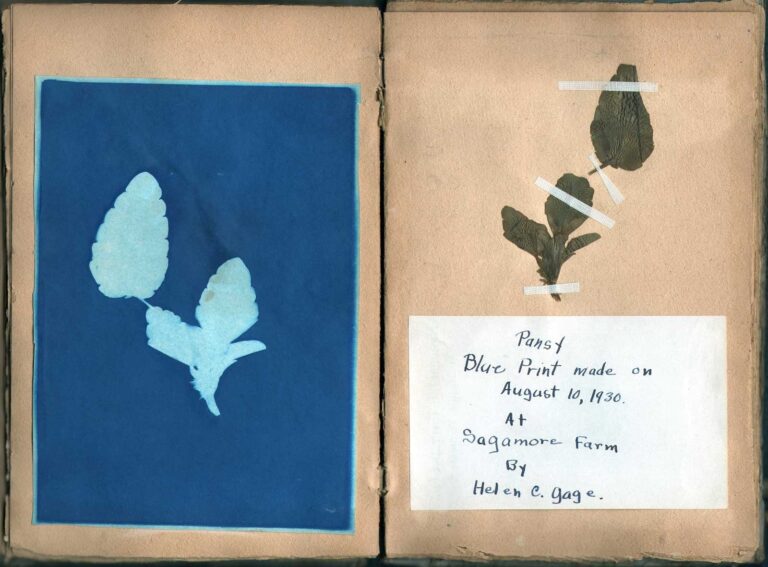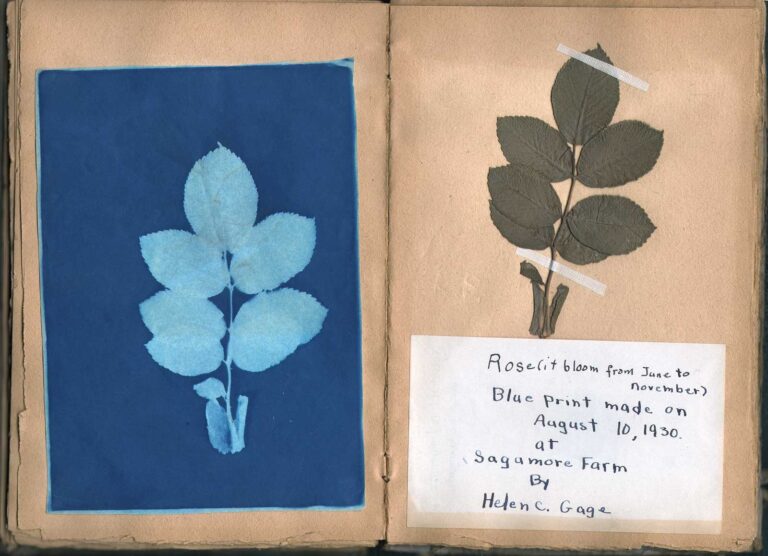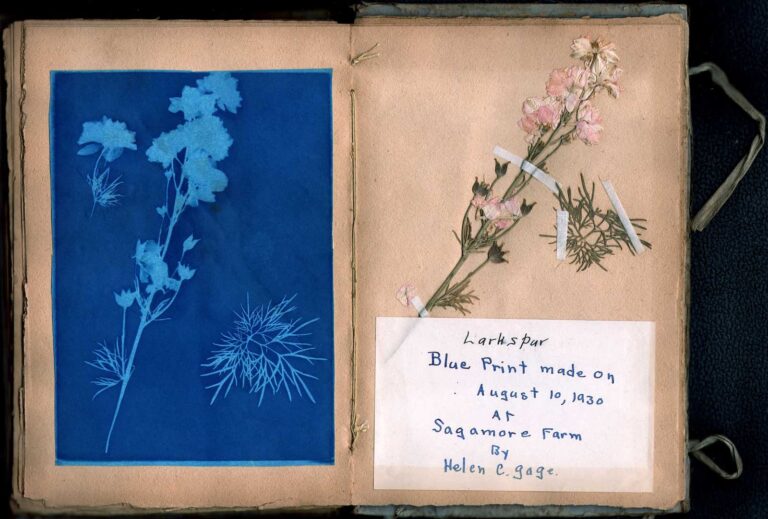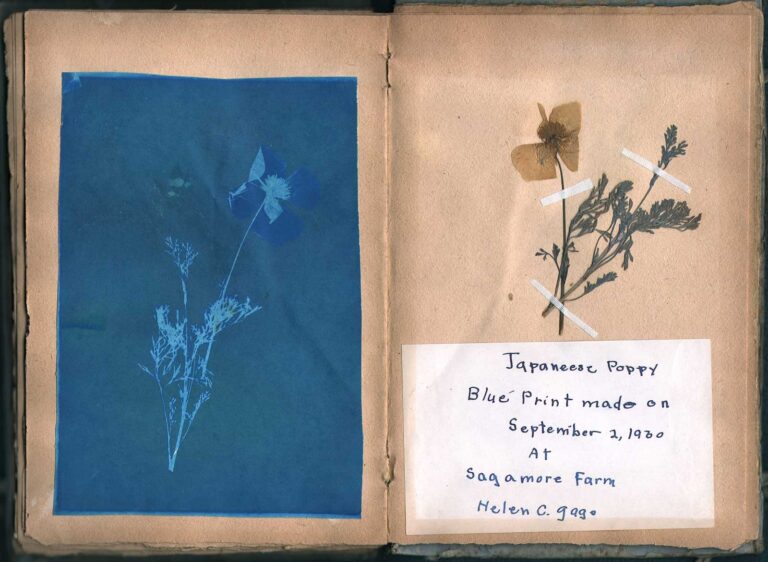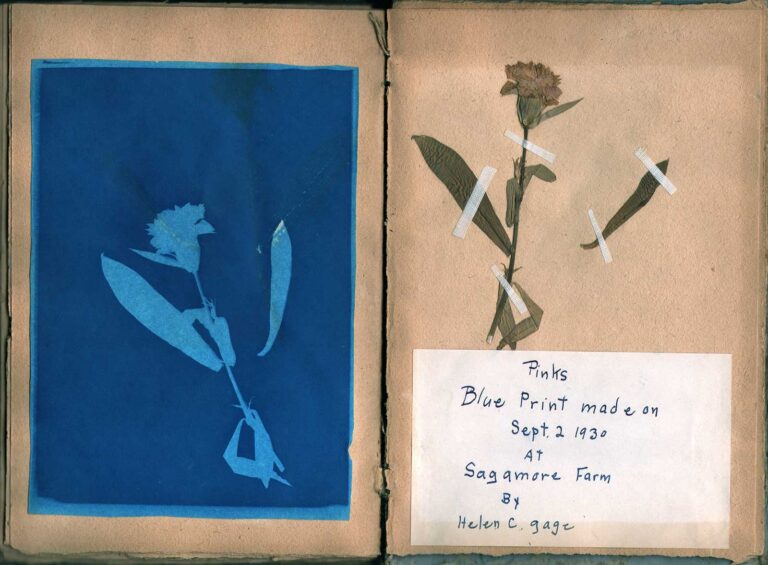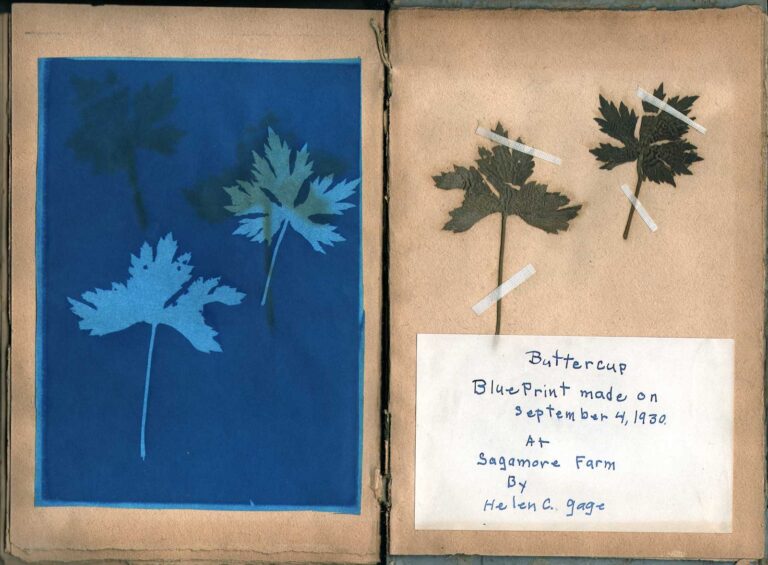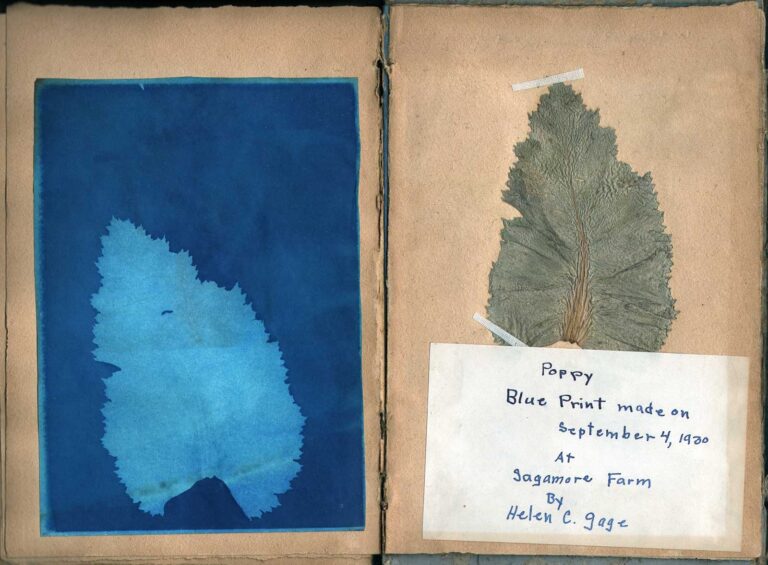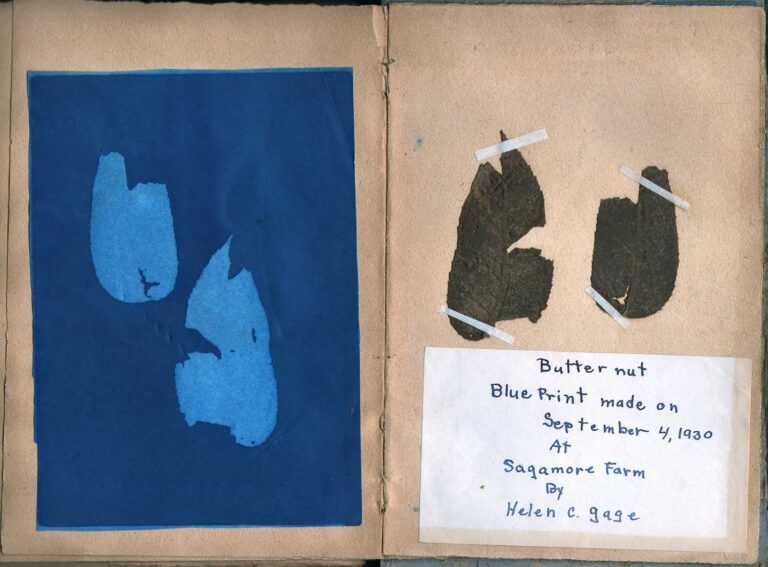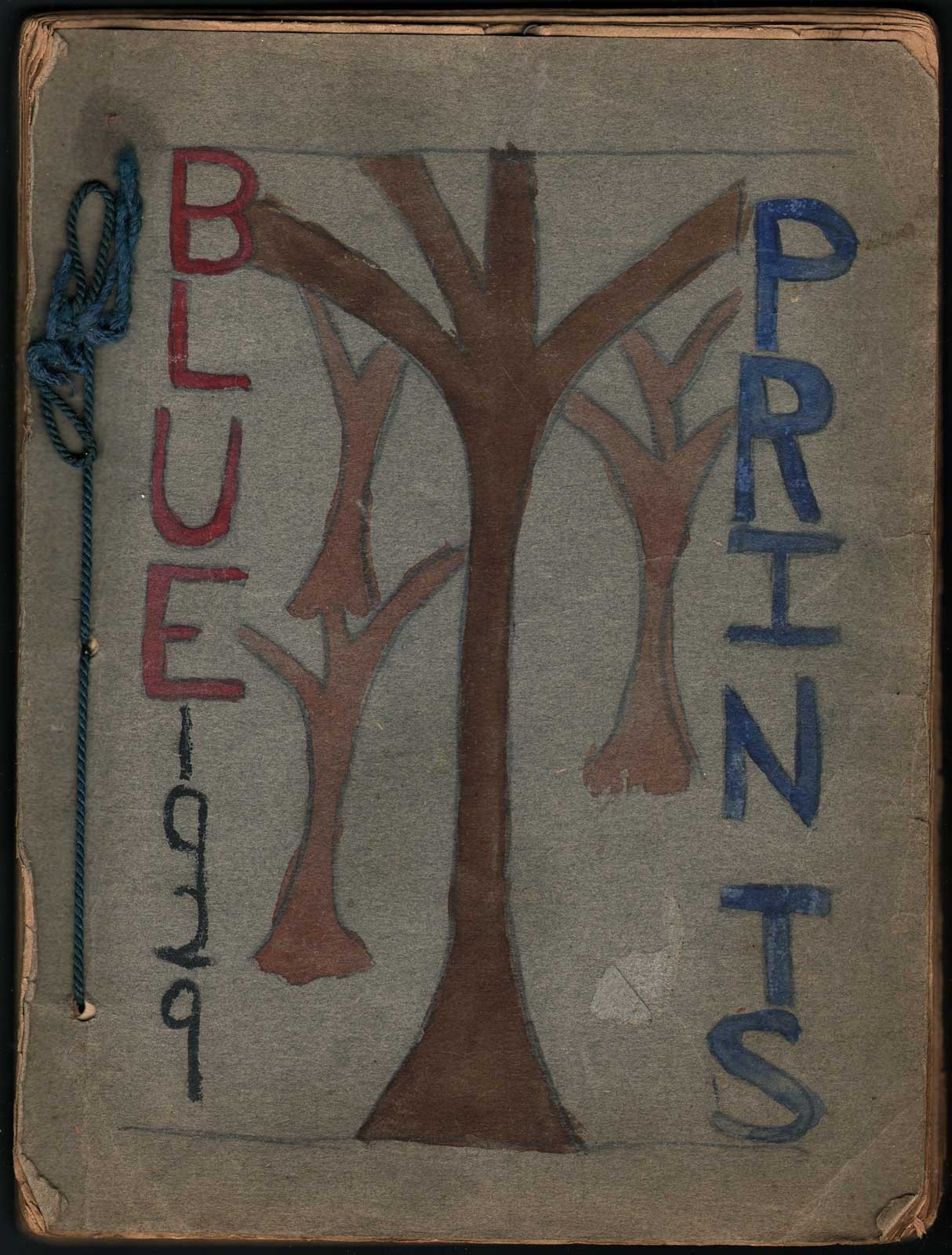
Blue Print Albums by Helen Chase Gage
American schoolgirl Helen Chase Gage (1917-1982) was between 11-13 years of age when she compiled these two “blue print” albums on the New Hampshire coast during the summer months of 1929 & 1930. Besides the delightful aspects of these cyanotypes showing a young artist at work, they endearingly further reflect a few misspellings by the hand of their creator. However, in order to retain the spirit of artwork, we thought it very important to include her original titles for each. Check out Helen’s hand-printed title labels carefully pasted to each album page. As I’ve stated for a few of the works that did not seem “right” botanically, I’m no plant scientist, and therefore possible her collected specimens made into the accompanying works are misidentified in some cases. Your expertise is welcomed! -David Spencer September, 2018
Writer Anna Soper contributes additional scholarship on these albums in her article These Stunning Botanical Images Are Blueprints of the Past found on the Atlas Obscura website published October 8, 2019.
Blue Print Albums by Helen Chase Gage
Cyanotypes from Sagamore Farm
The many cyanotypes from 1929-30 making up two albums shown in this group exhibition were taken by Helen Chase Gage. Helen was a schoolgirl spending summers at her family’s country estate known as “Sagamore Farm”. Formerly located within the present-day Odiorne Point State Park in Rye, New Hampshire, the estate was acquired in 1942 through eminent domain by the U.S. Government. Sagamore Farm was soon demolished along with other adjoining homes in order to build Fort Dearborn, which provided a coastal defense for the United States on the Atlantic seaboard during and after the World War II era.
The history of Sagamore Farm goes back to 1892, when Dr. William Duncan McKim, (1855-1935) a great nephew of Isaac McKim, one of the Baltimore and Ohio railroad founders, built a grand sixteen-room summer home he called Sagamore Farm. The Maryland Historical Society, which contains the William Duncan McKim Photograph Collection, notes McKim: studied medicine at Columbia and Leipzig and was the author of “Heredity and Human Progress”. Unfortunately, this 1899 volume espoused his advocacy for the Eugenics movement. He later married the violin virtuoso Leonora Jackson McKim. (1879-1969)
In 1918, the Boston Globe newspaper for Sunday, July 28 mentions that : Carl Gage of Boston has purchased the Dr McKim property at Odiorne Point. Helen’s father, Carl Webster Gage, (1882-1966) came from a prominent family in Haverhill, MA descended from Sgt. John Gage, who first came to America in 1630 and was one of the first settlers of the Massachusetts Bay Colony and a founder of Ipswich, MA.
Summer School Project by Helen Chase Gage (Miller) 1917-1982
During the summer months of 1929 & 1930, the woods, fields and gardens at Sagamore Farm are believed to have provided the botanical specimens for accompanying cyanotypes made and compiled into two albums by Helen Chase Gage, a young schoolgirl at the time. In the first album dated 1929, the hand-drawn cover artwork by Helen featuring four bare trees colored in brown watercolor is flanked by two words: BLUE and PRINTS, the latter embellished in blue watercolor. The “blue” aspect of the album is further emphasized in the use of blue yarn which binds the entire album of 29 individual blue prints together. The album features a Contents page dividing botanical specimens into three sections: Plants, Vines and Trees, along with two separate pages with blue ink, (naturally!) in Helen’s hand titled:
Record of my Blue Prints.
In the last part of June
I was in Miss Greve’s room and
She was doing something very
interesting. I asked her what she
was doing. She said, “I am making
blue prints.” I watched her for a
little while for I wanted to see
how she did them. So I could make
some doring (sic) the summer.
I asked Daddy to get me
some blue print paper. One week
end when he came up to the country
he brought me a yard square.
Because I knew we had some
blue print frams. (sic) They look like
This: glass | wood | Front view Tin wood | Backview
I will answer the question
that will probaly (sic) come to
your mind. How do you use it?
You put the leaf or whatever
you want to print.
(p. 2)
on the glass and then put
the blue print paper on top. Put
it in the sun until it turns white.
Take it out of the case and put it
in a pan of water untill (sic) it turns
blue. Then take it out of the
water and let it dry and your
blue print is all done.
I am making a book for my
blue prints. This is the organization
of my book.
Part I Plants.
Part II Vines
Part III Trees
You may see my book in our
class room when it is done
Helen Gage
When originally purchased, this album also included a loose sheet of lined composition paper written over in graphite by an older female hand for directions on how to make blue prints that has been clipped to the first page listing the Contents. Although this might have been done by Helen’s teacher Miss Greve, it’s also possible it’s by the hand of her mother Janette Gage, (1886-1977) with evidence below showing a guiding mother’s hand with previous experience in the cyanotype process.
On background, PhotoSeed has discovered amateur photography and the making of cyanotypes had already been of great interest to Helen’s parents. In June, 2018, the Vancouver, Washington bookseller Zephyr Used & Rare Books had listed for sale a series of four albums once owned by the Gage’s, featuring nearly 475 photographs, the majority being gelatin silver snapshots, but nearly a quarter being cyanotypes. These are dated ca. 1898-1916. Attributed to and compiled by Janette Wells Mitchell Gage & Carl Webster Gage, the bookseller includes the following detailed background on the content of the albums as well as important biographical information for Helen’s parents:
This archive of cyanotypes and silver gelatin photographs details the lives and adventures of a young woman attending Wells College, and her mining engineer and sales manager husband in the steel industry. The first group of material include photographs of a sales by young Carl Gage to Colorado in 1910, including a series of cyanotype images of the Mill of the Silver Lake Mine; views of Cunningham Gulch down from the Highland Mary Mine; the power house shooting water; the flatcar they rode down George Gage coming down the trail with sacks of silver ore; sacks of ore piled by the freight cars of the Denver & Rio Grande Railway, mining town scenes, street scenes, and more. The second album opens with a sharp cyanotype photos of Janette Mitchell & Carl Gage’s friends in the Missouri Volunteer Company C, 1898 for the Spanish-American War, identifying Laurence Boswell, Robert Nilson, Eugene Hine, and William Clifton. The rest of the album includes views of the Haverhill, MA family home, school friends, college friends at Wells, such as Florence Hardee, Captain of the Basketball Team in girl’s basketball uniform, theme parties, visits to Salisbury Beach, MA, and more. The third includes photos of relatives home on the St. Lawrence River, Mineralogy Laboratory at Wells, her Aunt’s home where she lived a while at 70 Main Street, vacations at Lake Winnipesaukee, NH, the Lafayette House in Franconia, NH in the White Mountains; a whole series of images of the Ostrich Farm in Hot Springs, AR; and trips to Florida. Final album includes an automobile trip to visit Index, Washington, with views of uncut timber, Main Street with advertising signs, the Skykomish River, and closes with views of their temporary home in Louisiana, and their 1916 Haynes Roadster. Janette Gage (1886-1977) was the daughter of a successful Haverhill, MA pharmacist, who studied pharmacy at Wells College. Carl Gage (1882-1966) was the son of a Haverhill, MA optician, who eventually rose to become District Sales Manager, and then Vice President of Jones & Laughlin Steel Co. (Bookseller Inventory # 54144)
1930 Blue Print Album
Unlike her 1929 album which featured only the resulting blue prints (cyanotypes) taken from botanical specimens, Helen’s 1930 album includes 31 individual prints along with the original collected specimens used to make them glued to the opposite album pages. We include these full album spreads as part of our online presentation.
Later Life: Helen Chase Gage (Miller) 1917-1982
Through newspaper clippings, a few additional details emerge of Helen’s life. Around 20 years of age, she returned to Sagamore Farm as reported in The Bronxville Review-Press Newspaper on June 24, 1937:
Miss Helen Gage has left with her family for their Summer home at Sagamore Farms, Portsmouth, New Hampshire. Miss Gage has just finished her freshman year at Ursinus, in Pennsylvania. She is the daughter of Mr. and Mrs. Carl W. Gage, of 2 Avon Road.
By 1940, the same paper on June 6 reports she would be graduating from Pratt Institute:
Miss Helen Gage, daughter of Mr. and Mrs. Carl W. Gage of Avon Road, is graduating Tuesday from Pratt Institute, in Brooklyn.
In addition to these two albums, Helen’s personal student notebook from Pratt covering the years 1939-40 documenting lessons taken (including some small individually-pasted artistic studies) as part of the Art History Course presented by school Director James C. Boudreau is held by this archive.
Might Helen have gone on to a career as an artist, using her much earlier experience creating blue prints as a child being the catalyst? At the time of this writing, this is unknown. Insight by surviving family greatly welcomed! The following corrected obituary of her life by the Review-Press Reporter newspaper of Bronxville appeared on June 24, 1982:
Helen C. Gage Miller died at Lawrence Hospital May 30 following a short illness. She was 64. A longtime resident of Bronxville and of Rye, N.H. for the past 50 years, she was born in Haverhill, Mass, in 1917. Mrs. Miller was the daughter of the late Carl W. and Janette Wells Mitchell. (Gage-editor) She was a graduate of the Bronxville High School and of Pratt Institute. She also attended Ursinus College. Mrs. Miller was a former employee of Lord and Taylor in New York City. She was a member of the Reformed Church in Bronxville, the Anne Hutchinson Chapter of the Daughters of the American Revolution and the League for Service. Mrs. Miller is survived by her husband Arthur W. Miller of Bronxville, a brother. Judge Edward A. Gage of Exeter, N.H., formerly of Bronxville a niece and three nephews.
